
ISSUE 23 SALIENT SALIENT FOOD
About Us
Salient is published by, but remains editorially independent from, the Victoria University of Wellington Students’ Association (VUWSA). Salient is funded in part by VUWSA through the Student Services Levy. Salient is a member of the Aotearoa Student Press Association (ASPA).
The views expressed in Salient do not necessarily reflect those of the Editor, VUWSA, or the University.
Complaints
Complaints regarding the material published in Salient should first be brought to the Editor in writing (editor@salient.org.nz). If not satisfied with the response, complaints should be directed to the Media Council (info@mediacouncil.org.nz).
2
Twitter @salientmagazine Facebook fb.com/salientmagazine Instagram @salientgram www.salient.org.nz
06—10 18—20 28—29 11—13 22—23 24—26 30—39 14—16 40—42 News Dusty Sunday Markets (Feature) Testing Viral Coffee Hacks Local Body Scorecards Centrefold Culture & Columns Ratatouille at Dad’s Place (Feature) Ingredients of Culture (Feature) Entertainment Find Us CONTENTS 3rd October 2022
Making Lemonade Out of Overpriced, Inaccessible, Subpar Lemons
EDITORIAL
Students are being set up to fail starve.
Last week, Salient reported on how unaffordable campus food had become (to the point where Krisha’s famous $6 plates are devastatingly no longer $6). Consistently buying food is not an economical option, so logically, students turn to cooking for themselves.
This is somehow just as unaffordable, since we don’t have access to cheap produce.
For students living around the CBD, the closest supermarkets are either New World or Countdown. Supermarkets in the city have considerably higher prices than their counterparts. Thorndon New World is notorious for being the most expensive New World in the country. My jaw dropped and my wallet wept when I paid $5 for a small head of broccoli and $8 for two zucchini during my last Countdown visit. Yet the closest PAK’nSAVE to the CBD is in Kilbirnie, making it inaccessible to many students.
The VUW Fruit and Vege Co-Op used to be the answer to our produce woes… until it died at the end of 2021. Katie Sharp, one of the co-op’s coordinators, said there weren’t enough students ordering from the VUW co-op to make it financially viable, but that other co-ops still existed around the city.
Our lack of access to affordable ingredients is why student potlucks never fail to amaze me. Some of you survive off plain pasta and toast throughout the week, only to pull up to a potluck with a chungus shepherd’s pie or a hefty tray of perfectly-iced cupcakes. Practicing manaakitanga through sharing kai is a beautiful thing, especially when that kai is made in a decrepit flat kitchen with a minimal budget.
When students manage to make sweet lemonade out of overpriced, inaccessible, subpar lemons, that’s credit to our creativity and resilience.
For anyone attending a potluck soon—TikTok tells me ‘butter boards’ are all the rage and have usurped charcuterie boards. Hop on this bandwagon before it goes out of style, because fuck buying cheese and olives in this economy.
You can garnish your butter board with parsley that you plucked from the Wellington City Council gardens around the train station. Alternatively, use rosemary that you foraged from the Botans when you thought no one was looking. Like I said, creativity and resilience.
In this week’s Food Issue, we visit the Harbourside Markets, discuss how food and cultural identity intersect, reminisce about nostalgic recipes, review coffee hacks and milkshakes, and lament over discontinued dressings.

In the wise words of Ratatouille’s Auguste Gusteau: Anyone can cook (even broke ass students).
Ngā manaakitanga,
 JANHAVI GOSAVI (SHE/HER)
JANHAVI GOSAVI (SHE/HER)
3www.salient.org.nz
Kia ora Salient,
I am a former student who used to contribute to Salient. I have read your article in the Sport issue titled ‘News Team Editorial: For Fucks Sake, Just Vote. ‘ I completely endorse this. Not only should students vote in the local body elections, they should vote in the VUWSA elections, they should vote in University Council elections, they should vote in the Rock 2000, the Triple J Hot 100 - GOSH people should vote on their friends Instagram polls asking if they have voted yet. If this is published and you are now reading this letter as a reader, get out and vote, its a wonderful way to get your voice heard. You’ve got very important elections coming up and your input is so invaluable.
Ngā mihi, TA
Mighty displeased by the Theatre Review of Skin Tight being published after the production is no longer showing. You cannot name something the “best piece of art [you] have seen in 2022” and then have said art piece be completely inaccessible to readers. Gorgeously written review, thoroughly devastating follow up google search.
- :(
Here is my poem about why Salient is different to other student magazines that I’ve read while at uni: Salient is not Critic Salient is not Canta Salient is not Craccum Salient starts with an S
Notices
Chinese Language(s) Week!
Last week was Chinese Language(s) Week! Discover New Zealand’s only collection of Chinese letterpress type at Wai-te-ata Press, RB006 Level 0 Rankine Brown, Kelburn. Learn about the New Zealand Cantonese community who used this type to publish their own newspaper during the mid-twentieth century, and of the current connections this collection has forged with Hong Kong and Taiwan in the special exhibition ‘Voice of Kaishu: A typographic journey’. On now until Wednesday, 26 October. For more info, see www.wgtn.ac.nz/wtapress
Talks for World Space Week
Join the New Zealand Students’ Space Association at a free event for World Space Week. This year, it’s all about sustainability, and we’ll be hearing from experts from Vic and the New Zealand Space Agency. Thursday 6th October, 5:15pm, HMLT104
Send your letters and notices to editor@salient.org.nz if you’d like them published on this page
Do you have a PSA that needs to be heard?
4 Letters & Notices
Letters
Now Hiring: Salient Editor 2023
Reckon you’ve got what it takes to run this wild and wonderful publication?
The editor manages and leads a team of paid and volunteer staff and has overall responsibility for Salient. Salient is produced weekly during term-time and comprises of 24 issues throughout the year.
The editorship is a full-time, paid position from January 2023 to October 2023 with an opportunity to work with the current editor this year to assist with the transition.
Two people may apply together as co-editors and the job will become two part-time paid positions.
Applicants should have excellent communication, leadership, budgeting and organisational skills and some management experience. An interest in student issues, as well as national and international affairs, is vital. Mainstream or student journalism experience is a bonus.
Applications should include a CV, portfolio of writing, and a cover letter outlining your vision for Salient.
Applications close Friday, 14 October at 5pm. Apply via Seek.
(Only Seek. Don’t email us. Read the instructions. Apply via Seek. Woohoo!)
5www.salient.org.nz
VUWSA’s 2023 Exec Members
Vaguely Promise to Increase Student Engagement
Words by Azaria Howell (she/her)
The results are in: Jessica Ye is VUWSA’s President for 2023.
Ye mentioned that “engagement” would be the biggest challenge for VUWSA to face in 2023. The numbers don’t lie—VUWSA’s presidential position has been unopposed for two years and events have low turnout, ending with heaps of leftover cold pizza.
Only 1,010 students voted in this year’s VUWSA election, and 153 of those didn’t complete the voting form.
Ye’s commitment to better engagement, a commonlyused Students’ Association buzzword, was lacklustre. Ye said “VUWSA had such an internal focus this year”, adding that she “wants to better prioritise reconnecting and re-engaging with the student body” in 2023, with no mention of how this would be done.
Nearly all of the candidates stated that engagement was VUWSA’s biggest downfall. Many did not give a tangible solution to fix it.
In terms of policy, Ye committed to “properly funding” student advocacy groups outside of the Students’ Association, including Ngāi Tauira and the Pasifika Students Council. She added that if these groups were not paid by the university, it was unjust “unpaid
labour”. Ye also told Salient that the university shouldn’t remove dual delivery and instead should push lecturer wages up to be consistent with the increased workload online learning brings.
On the idea of a second NZUSA referendum, Ye said she was “keen to put the idea forward” to the 2023 executive. Other candidates, including newlyelected VUWSA’s 2023 Welfare VP Marcail Parkinson, also backed a second referendum in spite of the controversies surrounding the first referendum.
VUWSA’s re-elected Engagement VP Katherine Blow said VUWSA need “better consultation” with students, citing the lack of engagement around the March NZUSA referendum as a regret from this year. Salient asked what that would actually look like. Blow said they’d like to see students incentivised to vote in VUWSA’s elections “if it was possible”.
Salient analysed the 2020 VUWSA election campaign material, and found that most common buzzwords used were “inclusivity, accountability, representation, and accessibility.” Two years later, this has barely changed and VUWSA candidates continue to provide great-sounding statements but remain vague on their policy.


6 News
Opinion: What’s Going On With the Tutors?
Words by Amy Jelsma (Ngāti Porou; she/they)
If you’re reading this, you’re probably a uni student and you probably have at least one tutor.
In my first trimesters of study back in 2020, the tutors I had were amazing. They seemed so grown up, so put together, and so cool. They rocked up to tutorials every week with impeccable Wellington fashion, delivered their lessons, helped out us struggling first years, and disappeared again until the following week.
After a couple of years at uni, I’ve seen behind the curtain. I am now a tutor and, as it turns out, tutors are just like the people they tutor! Tutors are stressed students juggling their own studies, work, and social life.
You may have seen recently the posters around the university saying “it’s time to attend a paid union meeting” and explaining “what [university staff] actually do”. These are all posters made by the Tertiary Education Union (TEU) to raise awareness of how poorly tertiary staff are paid.
If you didn’t know, VUW pays its tutors (and a lot of other staff) like shit. The TEU is trying to improve this. Currently, the highest possible VUW tutor pay-rate is lower than the starting rate for a Massey tutor. Pay rates at VUW have also not kept up with the inflating cost of living.
Last week, I got a $88 paycheck for my last ^fortnight of work as a tutor. I wish I was joking. This is typical pay for the weeks in the trimester when there are no tutorials and no marking to be putting in hours for.
I personally have a job outside of tutoring that I consider my ‘main job’. I’m lucky that I found a flexible casual contract that gives me regular shifts for the weeks when tutorials don’t run. We all know the student loan or allowance isn’t enough to live off either.
The fluctuating working hours of a tutor combined with the abysmal pay rates means that many VUW tutors find stable and better paying work in hospitality or at supermarkets.
Tutors get paid less than the living wage, yet we’re responsible for designing lesson content, teaching classes, communicating with students, marking assignments, and giving personal feedback. These facts should make you angry. No wonder VUW struggles to find enough tutors to work for them: what’s the point? It’s stressful, time consuming, and barely worth it.
Tutors receive little recognition from the university for how difficult our jobs are. There have been consistently disappointing pay offers put forward from VUW during the current bargaining term.
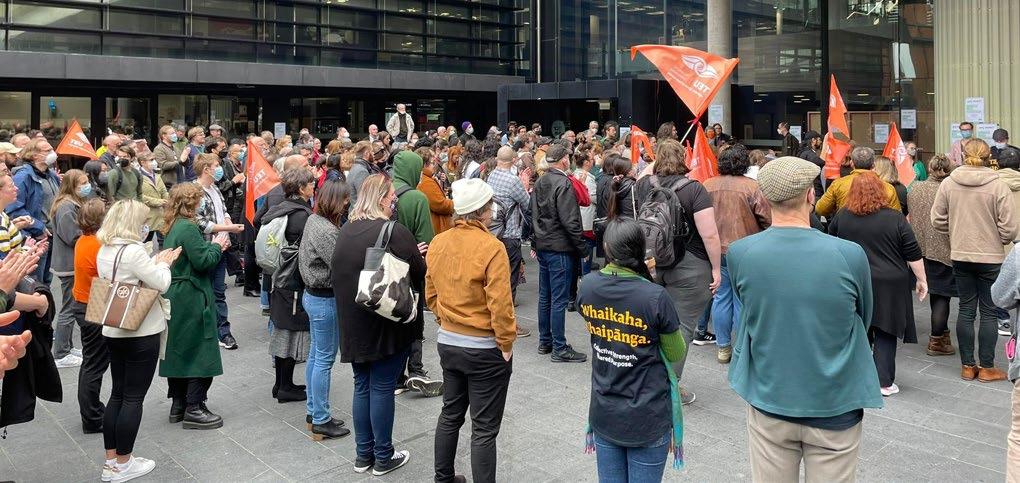
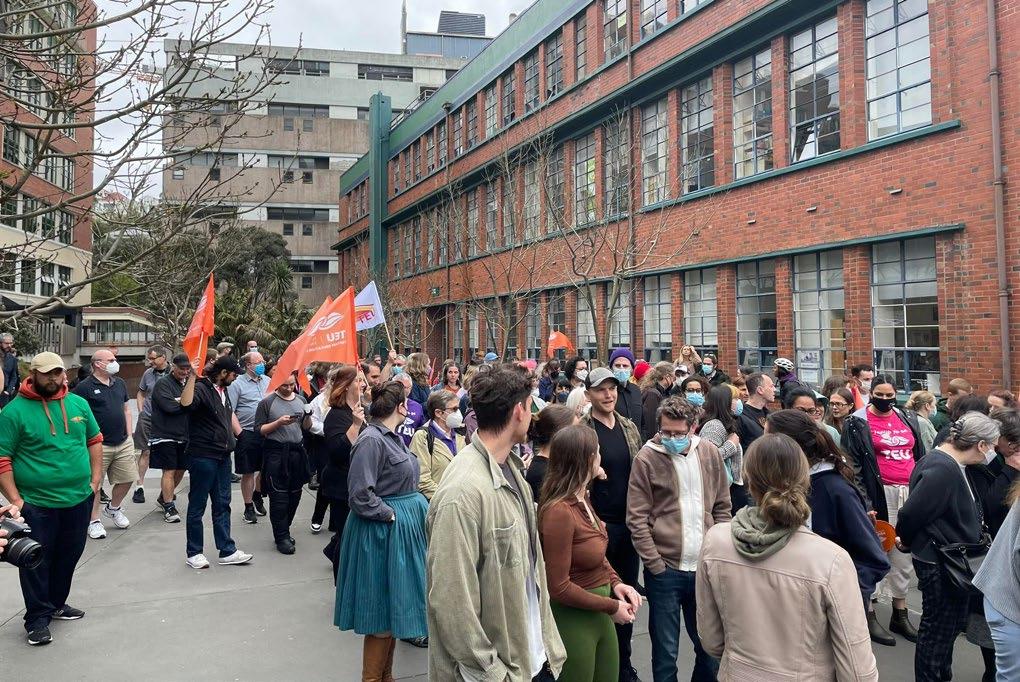
This, among other reasons, is why there was a unanimous vote at the 21 September TEU meeting in favour of opening a strike action ballot. In the next few weeks, all TEU members will be voting by secret ballot on whether we take strike action. This needs to happen before the trimester ends. That’s when we lose our bargaining power and ability to take industrial action. Note that only members of the TEU can legally participate in any upcoming strike action.
If you’re a tutor reading this, please join the TEU! It’s free for us because we get hired on such short contracts, and it takes about 90 seconds to sign up. If you work for VUW under the academic, research, or general collective, please also consider signing up. If you’re a student reading this, please support your tutors, teaching assistants, and other academic staff if we go to strike action.
Dear VUW, treat your staff better. Pay us what we deserve. Look after your staff so they can look after your students. If none of your staff can be fucked to do their job well, your students are going to suffer. If you’re going to run the university like a business, at least run it like a good business that at least pretends to care about its staff.
7www.salient.org.nz
Where Were All the VUWSA
Candidates? They’re Running for Uni Council.
Words by Azaria Howell (she/her)
The University Council elects a new student representative each year to serve a two-year term. VUWSA, on the other hand, elects a president who serves for the year. This year, seven students have put their hands up to run for Uni Council whilst VUWSA’s presidential position sits unopposed for the second year in a row.
Salient chatted with the candidates to understand why students flock to the Uni Council seats but evade VUWSA’s executive roles.
Lily Pearl, a candidate for University Council, stated that a lecturer convinced her to run for the position. If elected on the University Council, Pearl wants to bring attention to “parents on campus” following her own experience of having a daughter and feeling a need to postpone study. Pearl did not explicitly state why she did not decide to run for VUWSA, but mentioned that the position of student representative on University Council felt like an “extension” of her work as a student ambassador and PASS leader.
Steve Maran, another candidate for University Council, stated that small-scale communication issues could be to blame. “Vic sent a mass email clearly recruiting for a Uni Council rep, but VUWSA didn’t send a clear email looking for candidates.”
VUWSA does not have access to student email lists, preventing them from mass-emailing students to encourage them to run for the executive elections. VUWSA therefore resorts to social media engagement in order to get more candidates.
Steve Maran also added that VUWSA’s “strong political stance” may put students off of running for the students’ association. “People may perceive VUWSA as an advocacy service and perceive the Uni Council as a decision making body which leads them to find their time and effort to be more beneficial if allocated to the Uni Council.”
Essentially, Maran thinks that the Uni Council is more procedural and can lead to more change. A seat at the table may be more beneficial than a seat on the outside.
VUWSA Engagement VP Katherine Blow somewhat agreed with this point, stating that “there is an idea that being [a] Uni Council representative means you can do more and it’s more valuable [...] VUWSA is more unionism.”
Blow doesn’t necessarily agree with the idea that Uni Council is a better avenue to make change. They stated that some students who run for Uni Council want to work with the university to try to create reform and are of the opinion that “VUWSA always fights the uni”.
Despite an overwhelming agreement on VUWSA’s engagement problem, visibility may not be the issue. VUWSA hosts candidate debates for each executive election, whilst Uni Council voters have to go off a short blurb on the VUW website. VUWSA has a whole building in the university, but I couldn’t tell you where the Uni Council actually is or exactly what they do.
The line between engagement and visibility could be seen as crystal clear, but one student gave a different perspective. The student stated that VUWSA’s “inconsistent advertising” made it hard to follow, as “no one can tell when an ad is from VUWSA or not [...] it’s hard to know when to pay attention.” Amidst millions of different font choices, VUWSA’s communication can be hard to follow.
Another issue regarded careers, with another VUWSA executive member suggesting that a Uni Council position would comparatively “look better on a CV”. The executive member stated “if you’re going for a corporate job such as at PWC, they’d prefer [an applicant to be on] Uni Council [rather] than VUWSA.”
Kelly Mitchell, current Ngāi Tauira Tumuaki who is also running for Uni Council, suggested that the fame surrounding VUWSA’s elections could be off-putting. “I think there’s a lot more publicity around the VUWSA President, which can be intimidating [...] The amount that they speak to external media and the amount that other students will know and recognize them. I think for people who want to get involved in student advocacy in a more hands-on way, that kind of side is a bit scary.”
Despite this, Mitchell stated “there probably should be a bit more accountability and perhaps engagement with students with the Uni Council reps because there’s not that much interaction.”
Mitchell stated they were vying for the position on Uni Council to “hold [Nic Smith] accountable” and “provide some guidance” regarding te Tiriti issues.
8 News
Steph Edlin
Words by Beth Mountford (she/her)
Steph Edlin is 21 years old, a third year student at VUW, and running as an independent candidate for Motukairangi/Eastern Ward for the second time. Edlin says Wellington City Council’s “party politics” and “bullshit consultations” are motivating her 2022 campaign. She wants to improve consultation processes and trust between the council and constituencies. She says “Wellington City Council could really benefit from more people who are independent and just working on behalf of their communities.”
As an independent candidate, Edlin says she has to think “outside of the box” to promote her campaign. She has been standing in front of the badminton hall on Ruahine Street with a sign “a lot of mornings”.
“I dance my heart out and cars will beep at me,” she said.
Transport
The policy Edlin is “most passionate about” is investing in incentivising public transport use. For council, this means allocating bus priority lanes. “I’d love to see it actually take less than, like, 45 minutes to get into town from the remote peninsula where I live,” she said. She added that a lot of people “feel trapped” in the Eastern Suburbs. She would support free fares, but would not campaign on it.
Edlin says she wants to see council support public transport over any other transport mode, criticising cycle lanes as “polarising”, and cycling as inaccessible for people with disabilities or who can’t afford bikes.
Light rail is off the cards for Edlin. She says it is too costly, requires partnership with central Government, and is not practical when we have an existing bus network which could provide a solution sooner.
Water Infrastructure
Edlin also wants Wellington’s water infrastructure prioritised. She says the budget for this, allocated in the pre-election report, needs to be increased, and is concerned that the city doesn’t have enough peoplepower to tackle the job. She said she would like to see some lobbying for central Government to “get immigrants to come in or people from the rest of the country to solve our water infrastructure crisis.”
Wise Spending
Edlin’s third priority is to ensure the council is spending wisely. Specifically, she wants to see “spending allocated to what things that I think are essential needs for the city before anything else.” She says this entails spending on roading and water infrastructure as well as transport. Edlin admits this is “not, like, a sexy thing to campaign on”, however, she thinks it is more important than campaigning on “glorious things that aren’t necessarily the most practical”.
Why Should Students Vote For Her?
While none of her priorities are housing, Edlin says “I don’t think that you can be building housing when we don’t have our infrastructure sorted.” She would like to see crackdowns on empty properties in Wellington, calling the Gordon Wilson flats “disgusting”.
Edlin says students should vote for her because she “actually knows what it’s like to be a student and has relevant life experience that other older candidates don’t have.” As a part of this life experience, she cited “paying $250 for a mouldy room”. She says Wellington is a “city of young people” who deserve representation.

9www.salient.org.nz
Jonathan Markwick
Words by Ethan Manera (he/him)
Self-identifying as an “Angry Twink from Mt Cook”, Jonathan Markwick is running as an independent candidate for Wellington City Council to fiercely advocate for better housing for students.
Markwick studies Geography at Te Herenga Waka and works as a cleaner at the Greater Wellington Regional Council office. He’s keen on a promotion, campaigning for a seat representing the central Pukehīnau/ Lambton ward.
He hopes to get elected alongside current Green Party councillor Tamatha Paul and new Labour candidate Afnan Al-Rubayee, who he considered the “dream team” to tackle the housing crisis.
Housing
Markwick’s campaign is unashamedly dominated by his commitment to improving housing, pledging to be “a voice for the students and renters of Wellington”.
He decided to run after being dissatisfied by the current suite of candidates. “Before the cut-off [date], I was waiting and waiting for someone who is pro-housing to sign up, but no one did, so I decided to do it,” he said.
He acknowledged that fellow candidates Paul and Al-Rubayee are also “pro-housing”, but said other candidates are faulted by their support for “blanket character [housing] protection”. Markwick specifically called out incumbent Iona Pannett, who he said isn’t taking “the right approach for long term housing affordability” despite otherwise being a “great” and “effective” councillor.
The protection of character homes is something that Markwick believes is “immoral” and needs to change. “I do accept that
character housing is nice to look at but that’s now a luxury when there are 10,000 people living in motels and backpackers,” he said.
Transport
Inspired by the transport systems in places like Switzerland, Markwick is passionate about improving the city’s public transport system, being supportive of the Let’s Get Wellington Moving proposal for a light rail network across Wellington.

However, he says the current funding model is problematic: “I think the Government needs to actually fully fund it.”
Markwick also believes that opposition to the light rail plans has been fueled by “misinformation”. He rebutted claims by councillor David Lee who said the proposal would be the shortest rail network in the world, saying “there are at least 15 different light rail systems that are shorter.”
The removal of cars from the Golden Mile is another initiative he supports, saying that
community consultation has proven Wellington’s appetite for pedestrianisation of our central beltway.
Infrastructure
Another top priority for Markwick is water infrastructure. He said that “like everyone else” he supports fixing Wellington’s failing pipe systems. He is also onboard with the Government’s three waters reform, saying that if it goes ahead he would support the centralisation of our water entities. He added that the co-governance structure is a good aspect of the proposal.
Environment
A “healthy climate” is crucial to Markwick, who agrees there is a climate crisis. He said that part of combating climate change is enabling people to “get around” better, using modes such as “walking, bussing, and biking”. He supports “protect[ing] Wellington’s significant natural areas” as well as committing to “advocate for the planting of street trees in areas where significant intensification is occurring.”
10 News
Local Body Scorecards - Rank Lambton’s Candidates!
A Salient x Policy.nz Collab
To help you decide who to vote for, Salient has summarised every candidate’s policies about climate, housing, and utilities. You’ll see five empty circles next to each topic summary—colour them in based on how much you agree with the policies. Then add them up the circles to give each candidate a score out of 15.
We’ve covered the Pukehīnau/Lambton candidates because it’s the most student-dense ward in the city. You also need to cast votes for
Mayor, Greater Wellington Regional Council, and (depending where you live) Local Boards. To fill in these gaps, visit Policy.nz!
Local elections are run with the SingleTransferrable Vote (STV) system, meaning you can rank your candidates in order of preference – a 1 would go to your favourite. Get your vote in before 4 October if you’re posting it. Otherwise, your deadline to vote is 8 October!
Priorities
1. Climate-friendly transport
2. Develop more green spaces
3. Quality, affordable, accessible housing
Climate Change and Resilience:
Climate resilient, earthquake-proofed developments; better bus lanes, well-designed bus stops, clutter-free footpaths; improve stormwater systems.
Housing and Planning:
Support Healthy Homes Standards with council action; increase quality and quantity of council housing; build quality urban space.
Utilities and services:
Reduce, reuse, recycle waste, reduce emissions at landfill; fix the leaks, maintain the pipes, manage stormwater.
Jane O’Loughlin, 50 Independent


Priorities
1. Retaining character homes
2. Establishing an authority to build affordable homes
3. Reviewing LGWM priorities
Climate Change and Resilience:
Long term planning for climate change impacts; earthquake strengthening support for building owners; enable neighbourhoods against natural disaster.
Housing and Planning:
Retain character housing; consider Healthy Homes Standards enforcement options; establish a development authority to build affordable homes in under-developed areas.
Utilities and services:
Address leaks with Wellington Water; consider options for monitoring leaks in real time; enable the diversion of waste from landfill.
Ellen Blake (no age given) Independent
/15 /15 11www.salient.org.nz
Priorities
1. Zero Carbon Capital by 2040
2. Warm, safe, affordable homes
3. Affordable, dynamic, wild, creative capital city
Climate Change and Resilience:
Set a more ambitious emissions reduction target; oppose the expansion of Wellington Airport; establish a mana whenua-led Taskforce on climate adaptation.



Housing and Planning:
Complete Housing Upgrade Programme for council housing; strengthen District Plan to support livable homes; open a women’s emergency night shelter.
Utilities and services:
Water sensitive design for stormwater and slip management; create a circular food system; reconsider public ownership of waste services.
Karl Tiefenbacher, 54 Independent

Priorities
1. Stop the “Golden Mile”
2. Infrastructure over new projects
3. Logical, sensible, affordable decision making
Climate Change and Resilience:
Refocus anti-car policy into “get vehicles off the road as quickly as possible” mode; redevelop derelict earthquake risk buildings.
Housing and Planning:
More housing densification in the inner city; improve timeframes and lower the cost of build consents; family friendly, safe urban spaces.
Utilities and services:
Prioritise water infrastructure; increase street cleaning around the inner city.
Afnan Al-Rubayee, 30 Labour


Priorities
1. Safe, warm, dry housing
2. Infrastructure
3. Accessible and safe transport
Climate Change and Resilience: Implement blueprint to make Wellington a zero-carbon capital; develop a climate change adaptation pathway; support Three Waters for our water infrastructure.
Housing and Planning:
Strengthen the Spatial and District Plan for housing; re-develop route from CBD to Newtown with Let’s Get Wellington Moving; increased and faster housing development consents.
Utilities and services:
Support Three Waters reforms; start a city-wide food and green waste collection; retain public ownership of public assets.
Tamatha Paul, 25 Green Partyof Aotearoa New Zealand /15 /15 /15 12 News
Priorities
1. Prioritise infrastructure
2. Effective, affordable and reliable public transport
3. Nurture community spaces
Climate Change and Resilience:
Make public transport the most effective and cheapest way to move; consider recycling an essential service.
Housing and Planning:
Reduce inner suburb demand through effective and reliable public transport; pedestrianise areas of central city, changing carparks into vibrant city squares.
Utilities and services:
Maintain control of Wellington’s water infrastructure; adequately maintain infrastructure; prioritise infrastructure over other expenditure.
Jonathan Markwick, 30 Independent


Priorities
1. Enable more housing
2. Bus lanes and walking/cycling routes
3. Support Three Waters
Climate Change and Resilience:
Build more inner-city housing; reprioritise road space for public transport, walking and cycling; welcome government investment through its Three Waters programme.
Housing and Planning:
Allow housing where it is needed most; prioritise housing supply over “neighbourhood character”; support council efforts to increase housing supply.

Utilities and services:
Support planned investment in Wellington’s water infrastructure; welcome investment as part of the Three Waters reform.
Priorities
1. Reduce council costs
2. Listen to communities
3. Improve core services and government relations
Climate Change and Resilience:
Work with Government on an earthquake strengthening solution; clarify the Wellington Region Emergency Management Office’s role; improve bus service.



Housing and Planning:
Protect character areas; regenerate brownfield sites for mixed-use housing; review building consents process for efficiency and effectiveness.
Utilities and services:
Increase street cleaning and rubbish collection; investigate better solutions for rubbish and recycling; investigate and repair water leaks with Wellington Water.
Nicola Mary Jacobina Young, 67 Independent
Nicholas Hancox,
37 Independent /15 /15 /15 13www.salient.org.nz
RATATOUILLE AT DADS PLACE
Words by Maia Ingoe (she/her)
“The trick is to salt it first and then add shitloads of oil.”

We stand over his big gas stove, wheels of eggplant sizzling in two cast-iron pans. The sheer amount of the stuff, when laid out flat and coated in olive oil, is overwhelming. I half-heartedly poke the eggplants around the pans with a spatula. Dad calls it a fish slice, despite never using it for fish. “None of that American shit,” he’d say.
I always assumed Dad didn’t fit in the kitchen— scarred from a childhood memory of being served a plate of boiled cabbage drenched in butter. But he whizzes around, holding that old chopping knife with the melted black handle, dicing onions and crushing garlic under his big fist. Slicing courgettes, the green skin no protection for white flesh. The black singlet (he’d recently bought four, inspired by a stubborn attempt to match Wal from Footrot Flats) does nothing for his protruding stomach, just as the Repco cap does nothing for his growing bald spot. Dad discovered a new pride in cooking in his middleage, stemming from his friend who used to be a chef but couldn’t stand the hours. He boasts to me about what they’d roasted in the backyard and the latest fancy tricks he’s used to create a delicious meal.
“Here, they’re done.” He moves to the big pot where he shoves onions, courgettes, and assorted veggies extracted from the depths of his fridge (which I will not go near), pushing them off expertly with
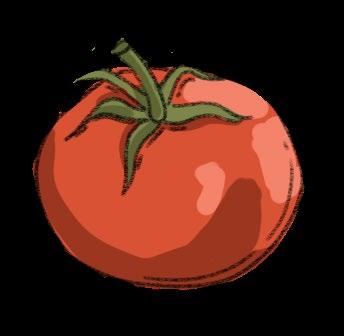

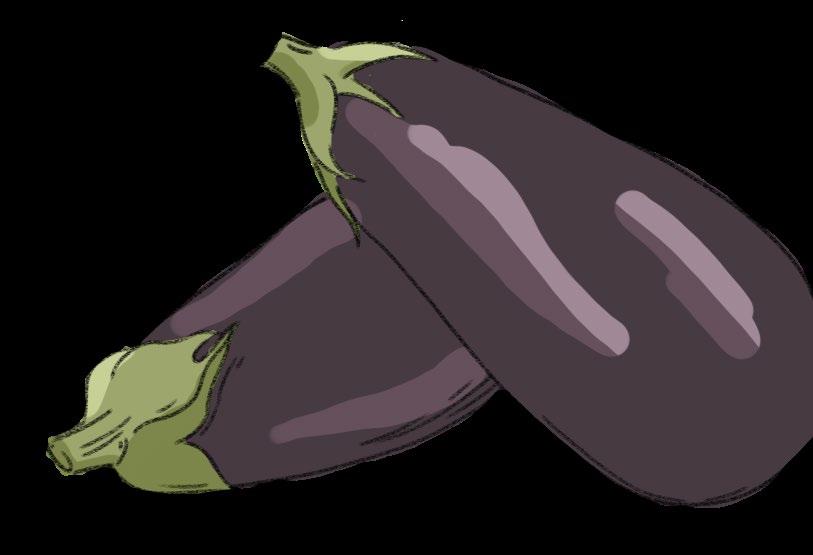

the side of his knife. I’ve long stopped bothering to check Alison Holst’s Vegetarian Cookbook for recipe instructions—Dad barks instructions quicker than I can find them. He tosses in the eggplants, browned and soaked in oil and salt. He hands me tinned tomatoes and I pour the bright juices over the oily mess. It bubbles around the edges of the pot. We add basil, some other herbs, and salt, salt, salt. Pepper too.
He shows me how to cook rice next. Mum has a rice cooker, so I have never bothered to learn. He cups the little white grains in his hand to measure the amount, tossing them into a pot on the back element. I struggle to light the gas stove, pushing the buttons again and again but never managing to hold the dials for long enough. I step aside for him to do it. “Put water on top of the rice and watch it soak it up—don’t let it get too hot, don’t let it bubble over.”
He dishes it all up together, serving it up on the fancy plates with radishes on them. The oiliness from the eggplant drips all over the rice. Hot, tomatoey, and filling. I’ve never had ratatouille before. I didn’t know it was something Dad could cook. I didn’t actually think Dad could cook much, to be honest. But our every-few-weeks cooking nights are proving me wrong. He puts some in a container for me to take home the next morning. He assures me that leftovers are better than fresh: re-heated in the microwave, the oily, tomatoey eggplant is definitely better.
14 Features
I search the cupboard. We have a pan, wide and deep, but with no lid. It has only been used once. I pull it out and set my freshly bought veggies on the chopping board. My Alison Holst Vegetarian Cookbook sits on the wooden pallet table, barely looked at. Home alone, I play music loud, taking a knife to the eggplant and courgette, trying to remember how Dad had cut them—thin, but not too thin, into round circles, easy to fry in oil. I push down the dial on our gas stove, lighting it with a little cigarette lighter in three tries. I lather the spongy eggplants with salt, then place them flat into the pan. They seem to explode in the copious oil, too hot. Canola oil (Dad would shake his head). Worried I haven’t added enough, I sprinkle more salt. The eggplant bubbles as I slice red capsicum, open a can of tomatoes. Our plastic spatula can’t pry the eggplant off the pan and they rip into pieces, burnt on one side. I chuck the little circles of courgette, the capsicum, and the tomatoes all on top.
Herbs? I chuck in some basil. Basil always works. A few of the fresh ones from the planter Mum has given me—only two plants are left and one has turned into a scraggly bush of dried out stalks. I add some more salt. We don’t have a pan lid, so I push the veggies into the middle, and try to keep them under a lid that is a good few centimeters off the edge.
I stand on tip-toes to reach my flatmate’s rice cooker, high on top of the pantry. How much rice—half a cup? A handful? My hands are smaller than his. I go for somewhere in-between, topping it up with water, forgetting to wash it first. I switch it on and let it do its work. Steam ries up, past the ventilator too coated in gunk to work. I open the window and wrap my sweater tighter. I grate the Edam cheese, stuffing my mouth with a handful. Next I search through the assortment of mismatched plates and bowls (there are never enough bowls), settling on the yellow one with the fruit and chipped edge.






When I moved into the flat, Dad drove down with banana boxes filled with kitchen stuff collected from op shops and around home. He set us up with slightly blunt knives and a Briscoes pot set and left us to it. I was filled with glee as I unpacked the boxes, thrilled by the idea of owning my own flowery plates. The ugly red EROAD mug he chucked in sits on the shelf. Knives, forks, spoons, some with the same curving trio of lines detailing the handle that we had at home. I reach for familiarity.
I text Dad.
“In honor of your birthday, made some ratatouille tonight. Think I fucked it up though.”
He replies almost immediately. We message back and forth about using fresh tomatoes and olive oil,





about adding enough salt but not too much salt (I now worry I added too much salt). Once the rice is cooked, I turn everything off and wait for my flatmate to get home from work. I video-call Dad, he’s having a beer in his shed. We shit talk for a while—I admit that I used canola oil, to his disappointment. “I’ll buy you some olive oil and post it down,” he says.
I get sick of waiting for my flatmate and lift the lid of the simmering ratatouille. Juice is pooling at the edges of the glass. I spoon in the rice, coating the chunky stew with cheese, and sit down on our blue couch in our yellow kitchen to eat. The oil isn’t right, could be more tomatoey. But there’s just enough salt. I add some more before I eat.

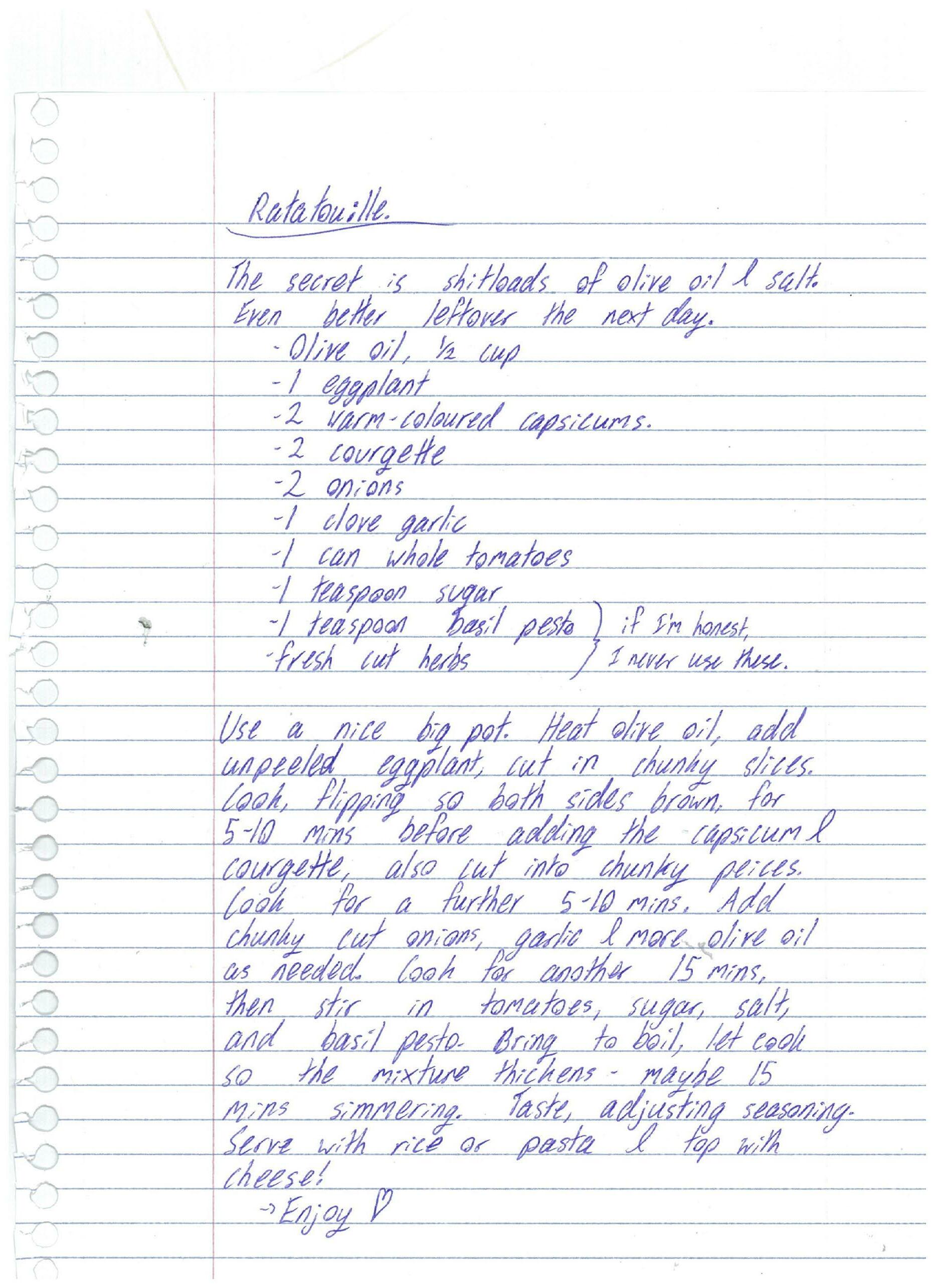
16 Features
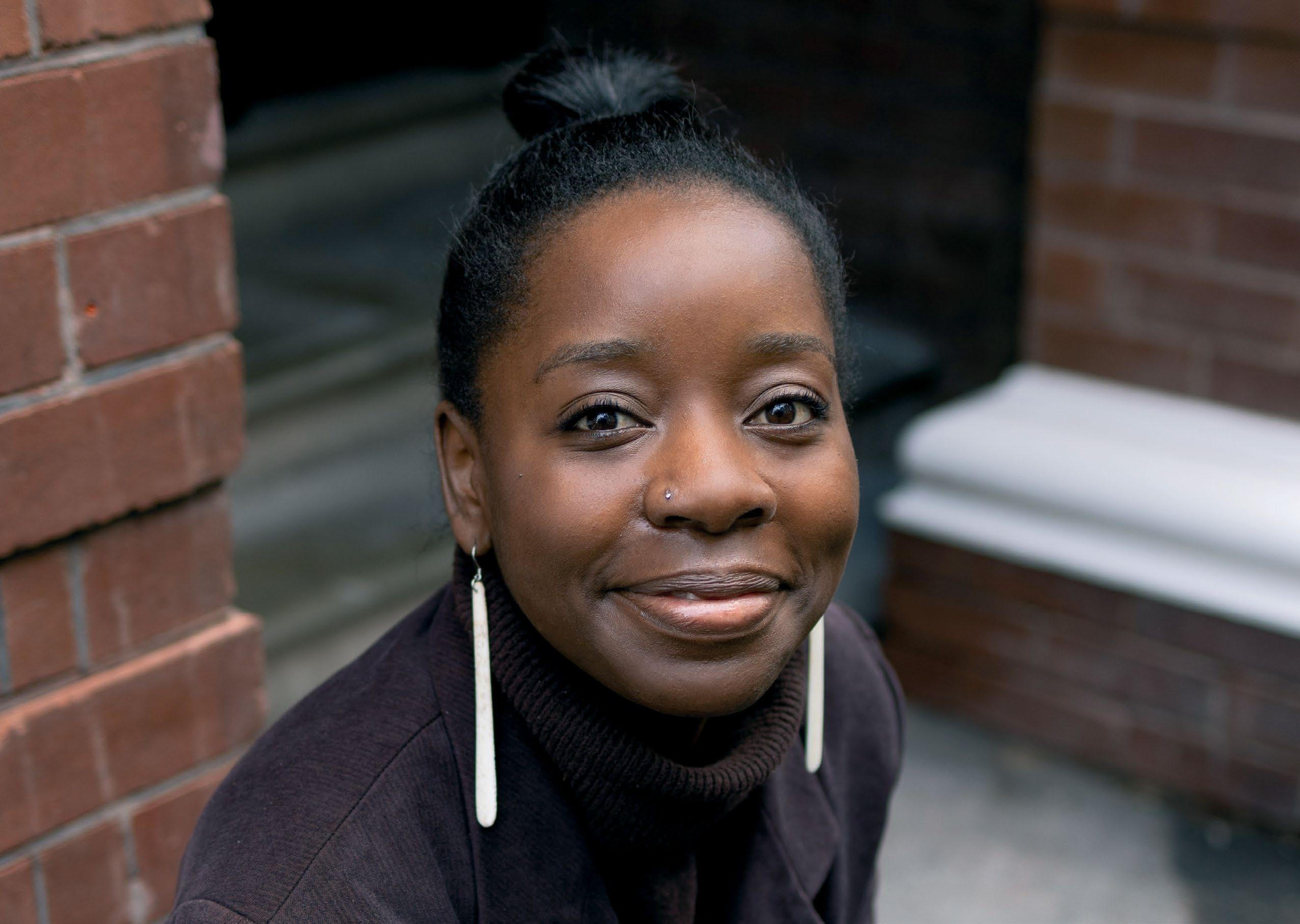
You’re voting, right? VOTEL O CALELE C TIONS22 S A T O C T 8V O T E B Y S A T O C T 8V O T E B Y S A T O C T 8V O T E B Y S A T O C T 8V O T E B Y S A T O C T 8V O T E B Y S A T O C T 8V O T E B Y S A T O C T 8V O T E B Y S A T O C T 8V O T E B Y S A T O C T 8V O T E B Y S A T O C T 8V O T E B Y S A T O C T 8V O T E B Y S A T O C T 8V O T E B Y S A T O C T 8V O T E B Y S A T O C T 8V O T E B Y S A T O C T 8V O T E B Y S A T O C T 8V O T E B Y S A T O C T 8V O T E B Y S A T O C T 8V O T E B Y Voting closes midday October 8, don’t miss this chance to have your say. Find out more at wcc.govt.nz/elections
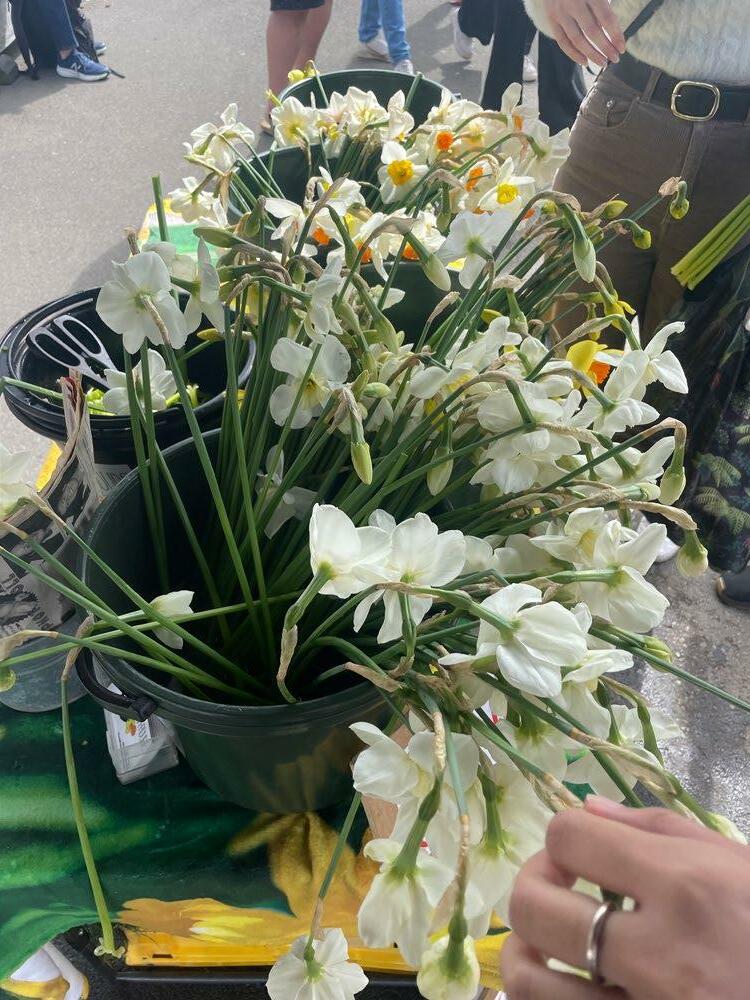
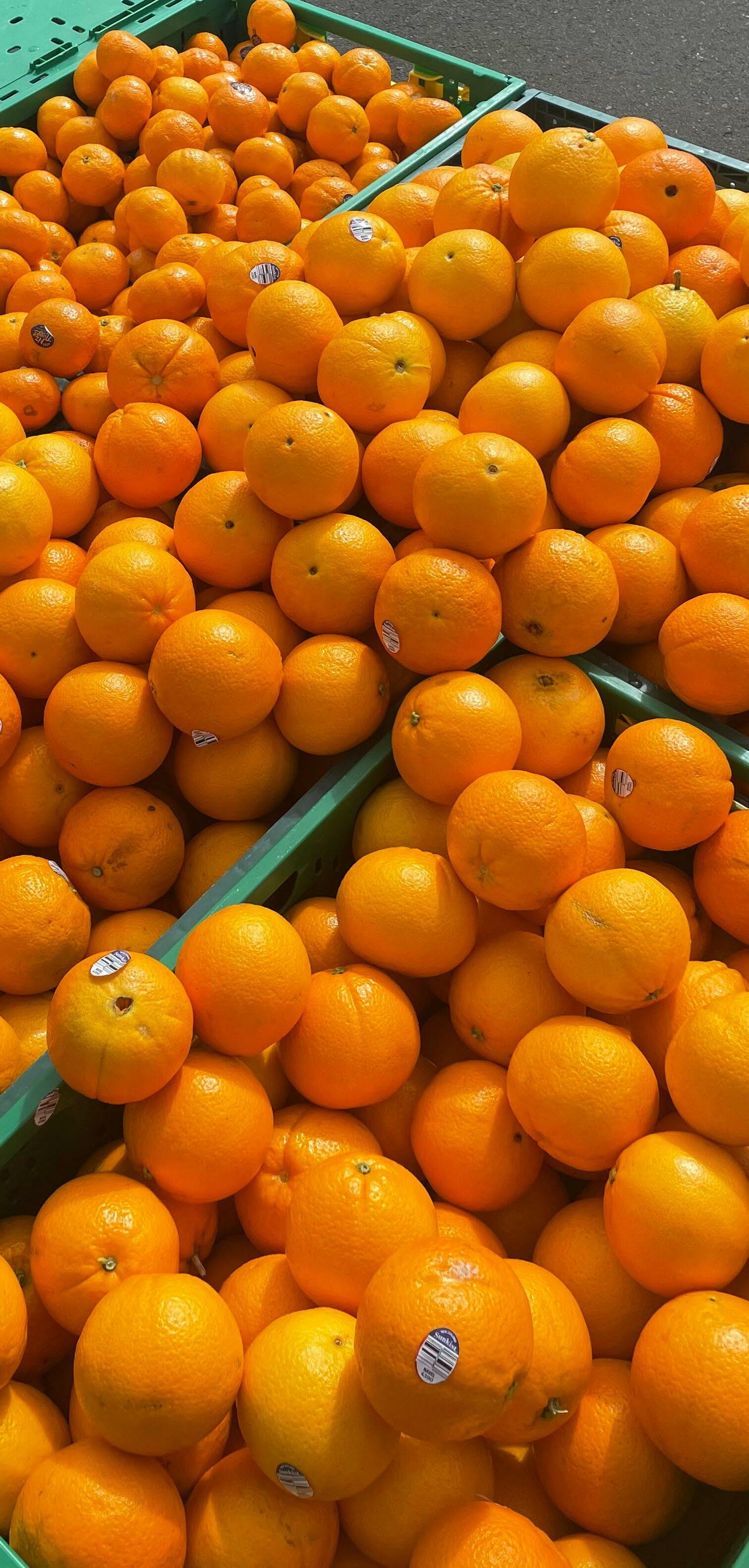
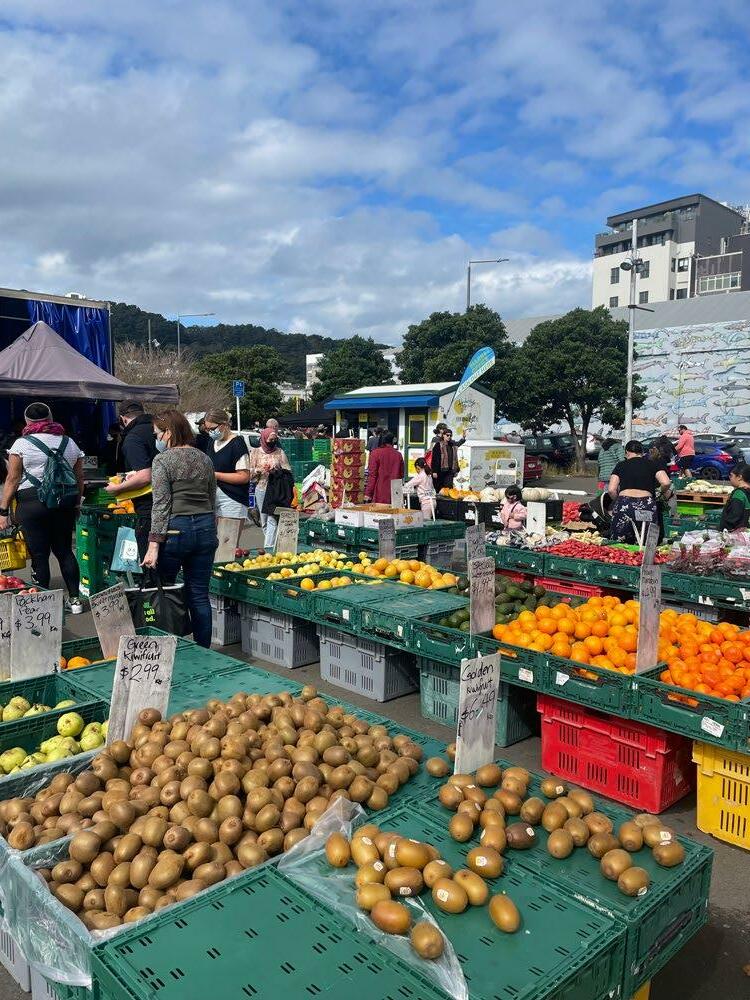
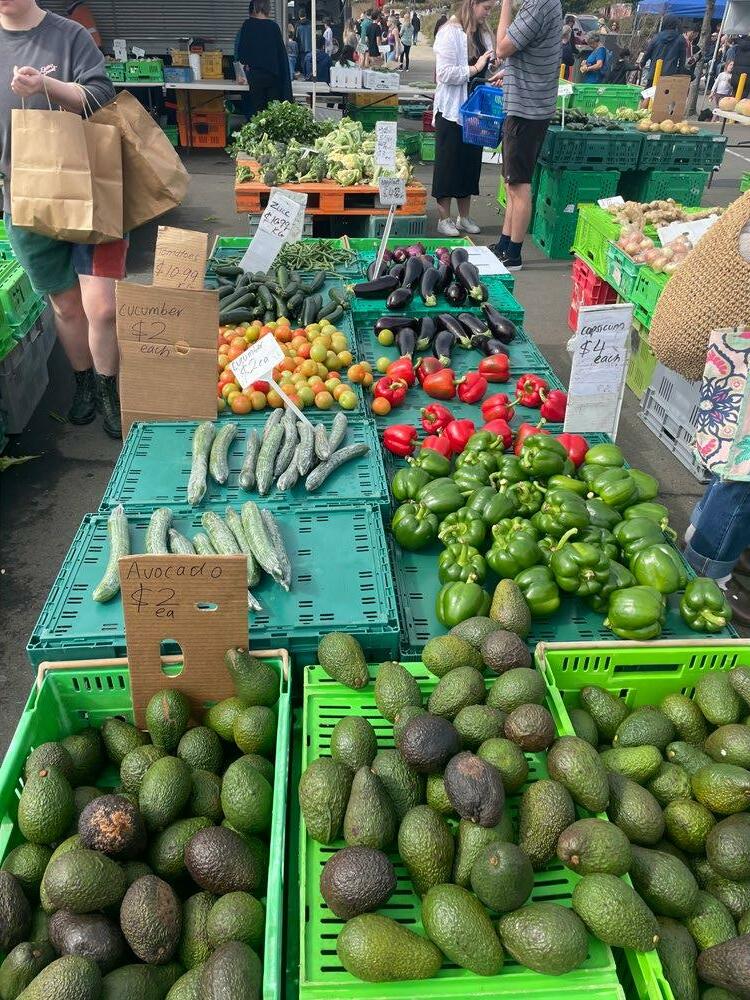
18 Features
DUSTY SUNDAY MARKETS
Words by Charlotte Smith (she/her)
It was a semi-sunny Sunday morning in Wellington and by some miracle I wasn’t hungover. Having a hankering for a pastry, I mustered the strength to get out of bed.
I decided to head down to the markets on Wellington’s waterfront to grab a bite and maybe pick up some groceries at the same time.
The Harbourside Market is a Wellington icon, running every Sunday morning outside Te Papa since 2002. However, 2020 marked the temporary banning of all community gatherings. The market was no exception, shutting down and inevitably falling off many people’s radars. Despite carrying out business again and its immense popularity, the Harbourside Market may be unknown to students who are new to the city or who have never come across it. I hate to admit that after being in the city for almost three years I’d only attended a couple of times myself. But that Sunday, I thought I would give it a genuine go.
My flatmate and I finally found a carpark after battling with hundreds of others and we made our way to the waterfront. Suddenly, we were immersed in a bustle of people from all walks of life and food and drink stalls of every kind. I was on a mission to find the perfect almond croissant (the obsession is real) and we found ourselves at Bordeaux Bakery’s stall, purchasing a croissant and a hazelnut pain au chocolat. A taste test of both was necessary for research of course. Both got a 9/10 rating—rare coming from a self-confessed connoisseur. Although I was full after my pastry feast, there were many
other stands that still piqued my interest. Fritz’s Weiners, with their mouth-watering looking German sausages in bread; doughnuts from The Little Chilean Kitchen; crispy whitebait fritters from Food for the People; and real fruit ice creams which screamed summer. All these delights sat alongside a beautiful selection of local produce—manuka honey, eggs, and avocados. A feast for the eyes and the stomach.
After wandering this stretch for a while, doing some people watching, and using all my self-restraint to not buy something from every stall, we made our way over to the fruit and vegetable stands. Situated in the car park next to Te Papa, this aspect of the market dates all the way back to the 1920s, when local farmers would come each week to sell their produce in the Blair and Allen Street area. Today, it hosts the produce of many farms in the wider region and families who travel every Sunday from as far as Levin to sell their fresh fruit and vegetables. The farmers are generous. Tony from Toby Jung Farms runs the Harbourside Market Partnership programme. Nowadays, all the stalls donate some of their products to the Kaibosh Food Rescue Charity after the market is over.
19www.salient.org.nz
Wandering around, I was overwhelmed, as there was just about every fresh product you could imagine. Meal planning might not be your forte, but wandering through the vibrant array of colours and aromas is bound to get you inspired. It’s easy to get over-excited and leave with a few extra items than you intended on coming for. Predicting this, the market sellers provide baskets and reusable bags for ease of shopping. After filling up my basket, I hopped in a line stretching all the way back through the boxes of produce to pay. The long queues speak to the quality and affordability of the food. Those at the counter were friendly and efficient, used to the pressure of serving large crowds.
I am both a huge foodie and a very broke student. These parts of my identity do not seem to correlate. Contending with the everincreasing supermarket prices is a constant battle. As much as I want to eat healthy and delicious meals, even when working as many hours as I can on top of studying, I can only afford the bare minimum. Buying cheese—a staple item —has become a treat. A bag of baby spinach, perfect for adding a bit of greenery to your meals, can be an absurd $6 at New World.
I know many students will relate to these struggles, which is why I think the market offers a solution. A huge bunch of spinach here can cost you just a few dollars. While I was at the market, I bought ingredients for a go-to lunch of mine: roast vegetable salad. A large kumara, carrot, two parsnips, broccoli, avocado, beetroot, and garlic came to just $9. I realised that the market is perfectly suited to those looking to eat well on a budget. It is us students who can reap the benefits of the market—maybe more than anyone else.
It is not only the market’s produce and price which is unmatched, but the atmosphere too. A young girl busked on her guitar, her voice a backdrop to the multitude of chattering voices.
I saw friends I hadn’t caught up with in ages. Families were out walking their dogs, couples were hand in hand, strangers were bonding with strangers. The food brings people together and it is this energy which makes the experience so special.
Yet as great as the vibe is, I understand that for many students it might not be at the top of their weekend to-do list. 90% of Sundays
I wake up dusty. On these occasions, the last thing I want to do is get ready, make myself look presentable, and go to a busy and loud market with forced social interaction. I get it. As much as I want to make it a regular routine, it is a struggle. But it doesn’t have to be a mission.
Grab a coffee from a local barista and coordinate it with a walk along the waterfront. Go for lunch and sit down on the grass outside Te Papa and people-watch, maybe visit the museum afterwards. You could get some groceries for your week and tick something off your to-do list. You could chat with some regulars and familiarise yourself with some local businesses. The store holders are all chatty and friendly. While snapping an insta-worthy picture at the vibrant flower stall The Daffadude, the stall holder asked me to tag them in my post. As happy-go-lucky as they seem, it is clear these businesses need our support. They need the students.
In our post-covid climate, supporting local and independent businesses has never been so important. It’s a relief that the market is up and running again, but stall owners and farmers are still suffering from the longterm effects of numerous lockdowns. The inconsistency of the market may mean a number of people, especially students new to the region, have never heard of it. This is devastating. The market offers an incredible showcase of what the region has to offer. Our attendance at the markets is vital to the stall holders’ lives and can be a great addition to ours.
For students who are new to Wellington, I can’t imagine a better way to get amongst the local produce and people. The atmosphere was so infectious that I almost didn’t want to leave. After finally dragging myself away, I headed home with a full stomach and an array of fresh goods to pop in the fridge. I was set for the week ahead and the bank account was not broken. I think I might just have to go back!
20 Features
Celebrating Grads with a $3,000 giveaway.

*Terms and conditions apply
We’re celebrating the graduating class of 2022. Register with MAS as a 2022 Grad, and get free advice on KiwiSaver and insurance for the chance to win $3,000*. Register at mas.co.nz/grad2022

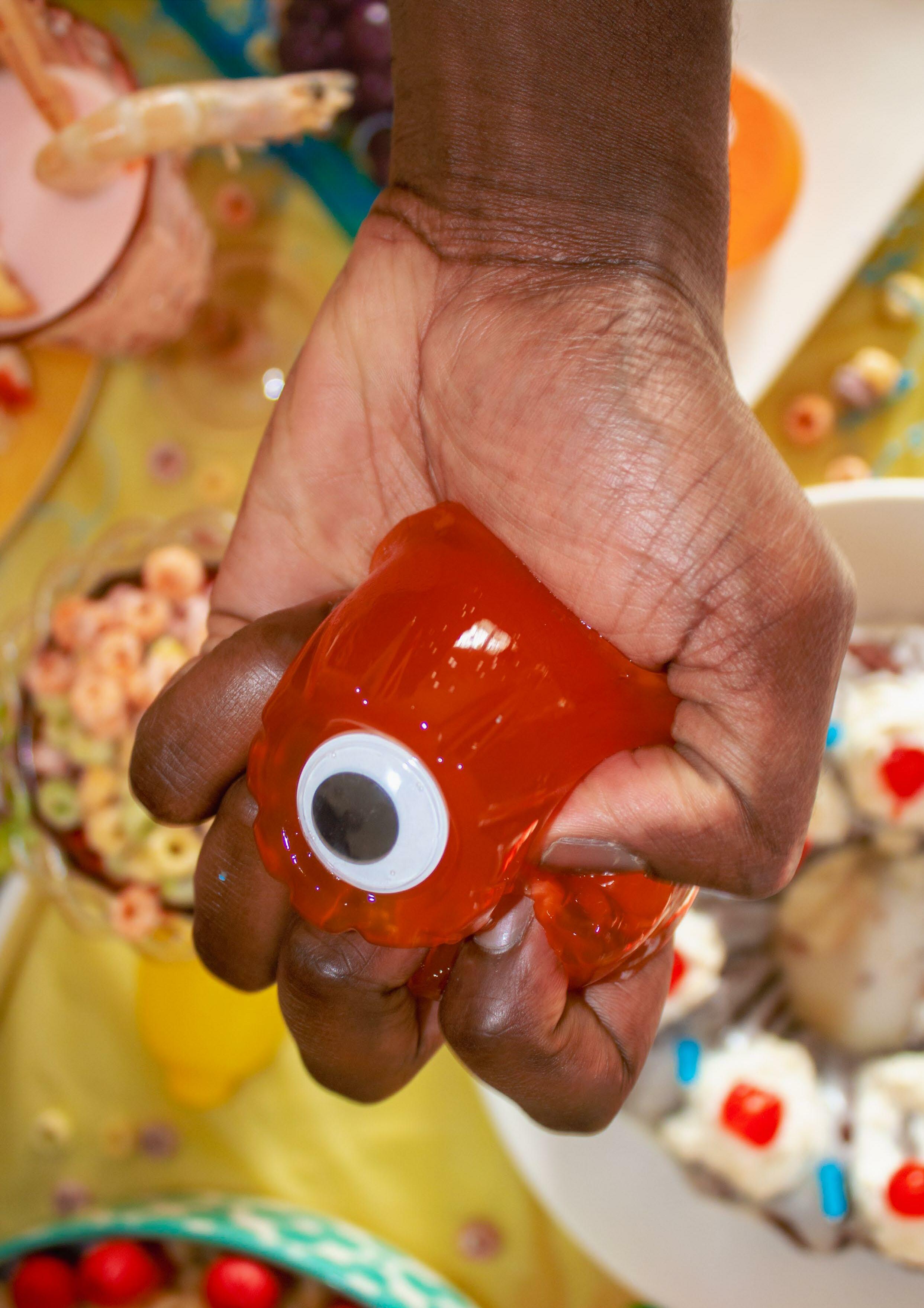 The Last Potluck, Alice Brown, 2022.
The Last Potluck, Alice Brown, 2022.

INGREDIENTS OF CULTURE
By Cileme Venkateswar (she/her)
Sometimes I wonder, if you were to lay me out (in a lab, on a kitchen bench, on a map, or on a cutting board), carved open and hollow for the world to see, whether you’d see which parts of me are Indian.
Would it be the way my hands know how to make morsels of rice and daal with my fingers without food ever touching my palm? If I were a recipe, whittled down to my key components, what would I be made up of?
Would it tell me exactly who I am?
BABA’S KHICHDI:
Ingredients:
Khichdi base:
1 cup of white rice (jasmine, basmati, any)
½ cup of red lentils
½ cup split yellow moong (also lentils)
4 cups water (+ more as needed)
Vegetables: Potatoes Carrots Cauliflower Frozen peas Tomatoes
Seasoning: Turmeric powder Ginger powder Cumin seeds Coriander seeds Chilli powder Mustard seeds
Dried red chilli Hing (asafetida) Fresh coriander Salt Butter / ghee / oil
*Note: Spice and vegetable measurements unknown—operate on instinct / vibes / The Look.
“I’m a bad Indian” slips from my mouth more times than I can count. But there’s something to be said about the fact that the only two words in Tamil I can truly use with comfort and familiarity relate to food: Thayir: yoghurt.
Kinnam: the little stainless steel bowl used for daal, sambar, rassum, thayir, etc. Autocorrect keeps changing my words to their closest English approximations. Every Indian word in this piece needs me to try different spellings in the Google search bar because I don’t know how any of these words look. I just know how they sound,
how they feel between my tongue and the grooves of my teeth. They don’t look how I imagined them to.
Lightly roast moong dal on a dry pan until golden brown.
Wash all grains + lentils well.
Transfer to a large pot and add 4 cups of water.
Add turmeric*, turn on heat and bring to a simmer. When language, traditions, and customs failed to translate across the two countries my parents leapfrogged to from India, food was the one thing that didn’t get left behind. It was the only love-language that could cross continents.
www.salient.org.nz
25
Indian families are notoriously terrible at emotional vulnerability. Nobody really talks about their trauma, about the people we’ve lost or the physical distance that separates us. But we’ll share recipes over WhatsApp and send photos of the meals we cook. We’ll treat each other to fancy dinners out when we’re in the same place. We’ll search for ingredients only found in Asian supermarkets that make our pantries feel complete.
When I arrive in India, no matter the time of day, my grandmother has made fried parval (pointed gourd) and payasam (a South Indian pudding). To me, the landmarks of the cities I grew up in are cafes, bakeries, restaurants, and supermarkets. (Specifically, that corner of Kolkata’s South City Mall food court where Kookie Jar, a patisserie, used to be. They moved to a new location on the other side of the city years ago, but I still expect it to be there when I visit.)
Cut vegetables* into chunks.
Fry vegetables on medium heat until lightly golden. Add vegetables to the pot and continue to simmer. Add more water as vegetables absorb it. Truthfully, without food, I don’t know how else to be Indian.
I’ve spent the last two years trying to make sense of all the traditions, knowledge, language, and culture that somehow got lost on their way to me. Carved open and hollowed out, there is so much missing that should be there.
Season with ginger powder*.
Roast coriander and cumin seeds* and grind in a mortar and pestle. Sprinkle into pot. Add chilli powder*.
There are days that I draw a bindi onto my forehead, hands shaky and uncertain. I still don’t quite recognise myself with it on. I have a Spotify playlist called “desi activate”, as though “desi” is something I can just switch on, as though it isn’t embedded in every part of me already. I never play any of those songs in front of anybody else because I’m afraid of people seeing right through me if I do. I’m afraid they’ll see how much of an imposter I feel listening to songs I don’t understand a word of, even though they should be familiar to me.
But still, a crooked bindi and a messy collection of music is better than years of declaring that “apart from my skin, I’m basically white.” Carefully arranged spice boxes are better than spending years favouring Western salads because diet guides concluded Indian food—crudely categorised as oily, carby takeaways—was “unhealthy”.
Lower heat to ensure nothing sticks to the bottom and add more water as necessary. Consistency should be thick and mushy. When rice, lentils, and vegetables are all cooked, add frozen peas* and salt* just before turning off the heat.
Three jumbo packets of parathas sit in my chest freezer (one is mine, the other two belonging to my now-obsessed flatmates since I introduced them to the flat bread that’s arguably better than naan).
On Diwali, it’s the endless rows of mishti at Newtown’s Indian Sweets & Snacks (the names of which I can actually pronounce) that makes the “I’m a bad Indian” spiel go quiet in my head.
Roughly chop tomatoes and lots* of coriander leaves.
In a pan, heat butter, ghee, or whatever oil you prefer.
Add cumin seeds, mustard seeds, 1 dried red chilli*.
When mustard seeds splutter, add tomatoes*. Add more ground cumin and coriander, ginger powder, chilli powder, and right before turning off the heat, hing*.
Once heat is off, add more chopped coriander*. The smell of cardamom makes all my senses alight with joy. The beauty of mint and coriander and tamarind all mixed together, or the smell from a tandoor oven wafting out from restaurant doors
I walk past, are a gentle reminder that it’s not all missing. I know Tamil and Bangla when I hear them. Parts of me can recognise where I came from, even if I don’t know what to do with it.
Check for salt and season as needed.
Garnish with cut lemons, chopped green chillies, aachar (pickle), and papaddum.
Serve with who you are seasoned into every mouthful, whether you can see it or not.
26 Features
Less than half of the population vote in Local Body Elections. That is no mistake. Apathy towards Councils is by-design. Councils were originally set up for landowners. But over time, those landowners started to rent out their properties to us and transfer the cost of their rates to us, their tenants. Attitudes that Council should only serve property owners persist and are reflected in low voter turnout and low engagement rates.
I don’t beat around the bush when it comes to advocating for our position as students. Some of us are living in homes that were around before Wellington City Council was even established. So many students have to scrap over the mouldiest remnants of the rental market while working multiple jobs and having to deal with unreliable public transport. That’s all on top of studying.
I became a City Councillor at 22. I was the President of VUWSA at the time. The second Māori woman ever elected to Wellington City Council. I wanted Councillors to do something about the awful flats that we have to live in and the eye-watering cost of living in this City.




I’ve taken on Quinovic. I’ve taken on the City’s most privileged by challenging the heritage and character protections which prevent us from building more housing. I have advocated for urgent climate action and got historic investment into climate action and low carbon transport systems. I’ve tried my best to ensure that our generation doesn’t have to pay for shortsighted political decisions down the line.
There’s no doubt that I have challenged the status quo which is why it is so important for you to cast a special vote if you haven’t voted already.











I’m the only Councillor in this ward who has the full support of the E Tū Union and the Green Party, backing me to keep going hard.

Every Councillor promises to make our City better and more prepared for the future, but few put their money, interests and pride on the line to do so. They promise low rates to those, who like them, own houses but ignore human waste flowing into the moana from bad pipes because they don’t want to upset homeowners in wealthy suburbs.

No matter which Mayor we get, if we have passionate and future-thinking representatives on Council, we can keep the City moving forward. It has been an uphill battle to get where we are now. That’s why it’s so important that you vote. It’s free. It’s relatively straightforward. Our future depends on it.


Postal voting papers sent out:

16th - 21st September Pukehīnau Lambton Ward www.tamathapaul.com @tamathapaul Vote #1 Tamatha Paul Councils aren’t justfor the privileged. In-person special voting: Anytime before midday 8th October at the Special Voting Hub at 107 Manners St If you don’t receive your voting paper in the mail, you can cast an in-person special vote: Authorised by T Paul, tamathapaul.com Open 9am - 5pm Until 12pm, 8th OctMon - FriTe Pokapū Hapori Community Hub, Manners Street
1. BAKING SODA TO LOWER BITTERNESS
Sounds funky I know, but apparently a small amount of baking soda is great for making coffee less bitter.
I used about a quarter teaspoon in my cup and was instantly scared by the smell of science-experimentgone-wrong that was wafting from my mug. I took a sip anyway and GOOD LORD IT WAS BAD. It tasted like pure disappointment and regret; a sharp, eggy, metallic taste worsened by bitter black coffee.



I knew coffee could kill you, but I didn’t know it could upset you! I braved the bad smell and taste and had a measly teaspoon. It actually did make the coffee less bitter. I would recommend only a small pinch of baking soda so you don’t get an awful (and frankly scarring) mouthful.

2. BUTTER FOR A BETTER TASTE 3. A SPOONFUL OF SUGAR SALT HELPS THE MEDICINE GO DOWN?
You would think this one would’ve worked. But my hopes were shattered. Supposedly, adding butter to coffee as a substitute for milk and cream can taste quite nice and can have various health benefits depending on the butter used. I added two teaspoons of butter to my coffee and noticed that an unpleasant film had developed on the surface. When mixing the coffee, the butter separated to
I was dubious about this one, but it worked! Adding a pinch of salt to my coffee did indeed mimic the taste of sugar. Of course, for lovers of sweeter coffee, adding more salt would not make the coffee sweeter.
So take this hack with a grain of salt (pun intended).
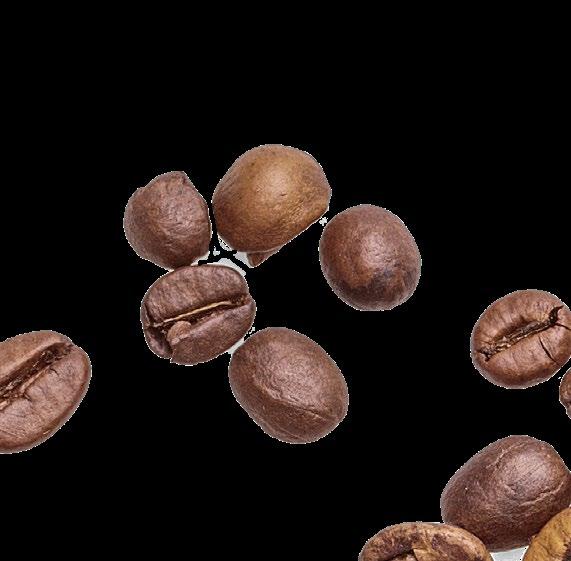
28 Culture TESTING VIRAL (AND QUESTIONABLE) COFFEE HACKS TESTING VIRAL (AND QUESTIONABLE) COFFEE HACKS
Words by Lauren Pemberton (she/her)
While I need plenty of food to get through the weekly uni grind, my primary form of sustenance is always a cup of coffee. Although there are many kinds of coffee out there, there are also many hacks on the internet to spruce up our good old cuppa. So, Salient readers, I decided to drink way too much coffee for one day and put some of these coffee conspiracy theories to the Ultimate™ test.
4. THE ELUSIVE DALGONA COFFEE TREND…
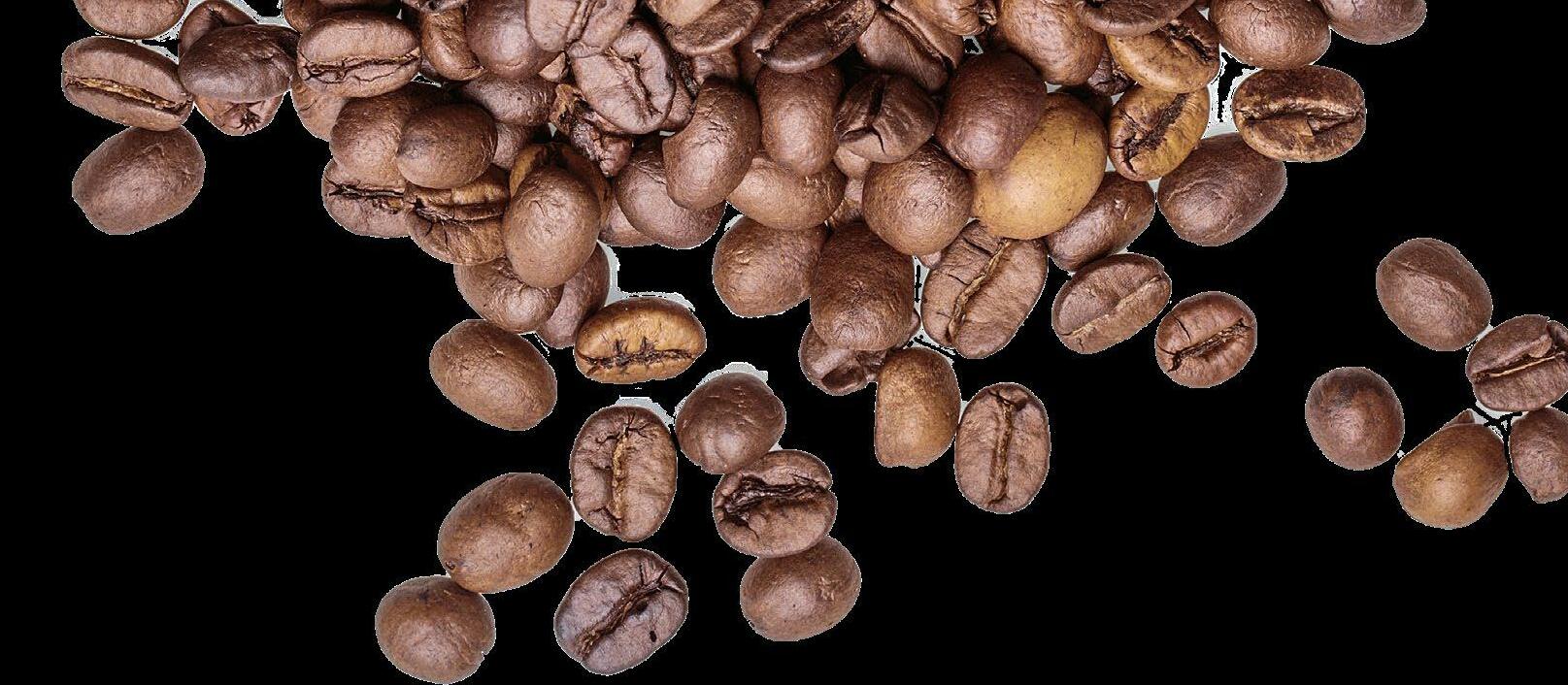


I couldn’t NOT do this one. Dalgona coffee is a creamy beverage that went viral on TikTok. It’s a mixture of milk and ice with a fluffy coffee mixture on top that’s totally Instagramworthy. To test the trend, I first added two tablespoons of instant coffee, two tablespoons of sugar, and two tablespoons of hot water to a bowl. I whisked all of the ingredients together to get a fluffy mixture (this took 10 minutes and killed my right arm). After that, I filled half of a tall glass with milk and ice cubes, then used my inner coffee artiste to pour the whipped coffee on top. I had high hopes. OH MY GOD IT WAS AMAZING. Not only did it look boujee, but the taste brought out the very best in my cheap instant coffee—sweet, with the right amount of bitterness and coffee flavour. A lovely iced coffee remained when the coffee ‘fluff’ melted into the milk. I have a big sweet tooth, so it was pleasant for me. But you can lower the amount of sugar if sweetness isn’t your vibe! The sugar is also meant to create a fluffier texture. More sugar = more fluff. I would also advise using a straw to drink Dalgona coffee. I got a massive mouthful of coffee fluff when I went in for a sip. All in all, TikTok has done it again, and the arm workout was well worth it.
5. COFFEE ICE CUBES (YES, THEY’RE A THING).
If your iced coffee is getting watery and tasteless as the ice cubes melt, freezing coffee in an ice cube tray instead of water will fix this! When these Pinterest-approved ice cubes melt, they add more coffee and don’t take away from the taste of the drink!


If anything, my coffee just got stronger. There was a layer of melted-ice-cubecoffee that formed at the top, but this was easily fixed by simply stirring the coffee a bit.
After my coffee-hack odyssey, it’s safe to say that you definitely should not add baking soda or butter to your coffee! Coffee ice cubes and whipped coffee on the other hand? Total wins. At the end of the day, coffee is a university student’s partner in crime, regardless of how you make it. The power of a good coffee is second to none.
CONCLUSION
29www.salient.org.nz
Words by Azaria Howell (she/her)
I love energy drinks. A fresh, cold Blue V in the morning gets me ready for my day and nothing tastes as good as a Vodka Red Bull on a night out. Milkshakes are another timeless classic. They are smooth and tasty, coming in a wide variety of flavours including chocolate, salted caramel, and even lime. Add two straws to one and you’ve got a date.
As I was scrolling through the Night ‘n Day menu on DoorDash, an intriguing combination met my eyes: energy shakes. It was the uncanny valley of drinks and it sounded so goddamn horrible I just had to try it.
Night ‘n Day Energy Shakes come in two different flavours: Red Bull and V. In the name of unbiased, quality journalism, I tried both with an open mind. Welcome to a quality culinary experience not even Gordon Ramsey could dream of.
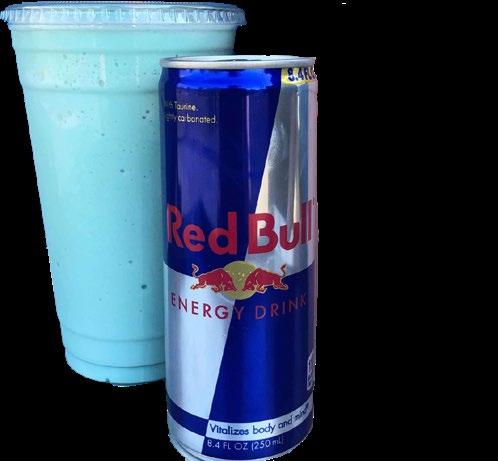
Red Bull Energy Shake: 7/10
Red Bull is an absolute classic, though the thought of having one blended with milk and whipped cream makes my stomach churn. Despite my preconceptions about the atrocities of this food fiasco, I went to have my first sip.
Maybe it’s because I drink Red Bull more often than Green V, but this one definitely had a more distinct ‘energy’ taste. It somewhat resembled an energy drink flavoured vape juice (don’t ask), as hints of Red Bull shone through the creamy drink. Once again, it was inexplicably white, despite Red Bull having a pisslike colour. I’d order this again, quite honestly. There was not one curdle in sight—it was tasty, yet a little more strange than the first option.
Despite thinking I would give myself chronic food poisoning from these flavour combinations, I’d order both of these again. They really surprised me.
V Energy Shake: 8/10
As I ordered this one, I admittedly got a little confused. V comes in a variety of flavours. Was this Green V? Was it Blue? Resemblant of an ABBA track, the V Energy Shake took a chance on me and I let it.
It was actually good. The flavour was definitely more Green V than Blue. It was hard to tell though, as the drink was white, leaving the flavour profile of the shake up to taste alone.
It was sweet and milky, but it wasn’t bad or weird at all. I was shocked. I took a double take at my order. It was actually decent. I was amazed at the shake’s consistency. Before I tried it, I was convinced it would be some sort of curdled mess. It was a smooth, cold, and refreshing new take on an energy drink. Sure, it wasn’t as classic as a chocolate shake, but the citrus-infused guarana taste mixed with smoothness wasn’t the food crime I imagined it to be. This was shockingly good and that’s coming from someone who usually hates Green V.

30 Culture
REVIEWING NIGHT ‘N DAY’S ENERGY DRINK MILKSHAKES REVIEWING NIGHT ‘N DAY’S ENERGY DRINK MILKSHAKES
REST IN PEACE ETA’S SOUR CREAM & CHIVES DRESSING
Words by Ash Putt-Fallows (Ngāti Whātua, Ngāpuhi, Tūhoe; she/her)

In 2017, my whānau faced one of its greatest losses when Eta’s Sour Cream & Chives Dressing was heartlessly taken off supermarket shelves.
When reflecting on this loss, I first spoke to my nan.“It was really nice dressing,” she said. My whānau has never been too talkative about this kind of stuff. Her dog Bella also made it clear what her position on the dressing was by barking loudly.

My mum said: “Def agree was a devastating loss.” She also asked if I was somehow going to get Eta to start making the dressing again with three question marks. It’s hard watching a family member in denial.
My little sister Jess was one of the more affected family members, as potato salad is one of her “favs’’. She recounted a moving story: “Potato salad was something I was raised on. It was the foundation of my childhood and something that brought our family together. No matter what disagreements everyone had, a nice bowl of potato salad with the Sour Cream & Chives Dressing always brought us closer together. I remember the day they took [the dressing] off the shelves so vividly. We were searching for it, ready to make the delicious and heartwarming potato salad for Christmas. Our search was unsuccessful. Devastated, we ventured home thinking that it must just be out of stock. Upon arriving home, we did some research and found out that the sauce had been discontinued. This moment
was the true Great Depression. Shortly after, our family turned from one that was caring and loving to one that was constantly at each other’s throats. I can’t even tell you the last time I spoke to some of my cousins. And to think that this could’ve all been avoided if Eta kept making its silly little sauce.”
I reached out to Eta for a comment. I asked why they would do something so heartless, so evil. Their response? “Usually, when we take a product off the shelves, it’s due to one of two reasons. It either wasn’t selling enough or we could no longer source the ingredients.” Clearly it wasn’t lacking in sales. We bought enough to sustain the whole company. Just tragic.

I would also like to acknowledge my poor, poor aunties who were drastically affected by the loss of the Sour Cream & Chives Dressing. I considered reaching out for comments, but ultimately I feared it would create too much stress.
To this day, my whānau and I are still healing from the loss of Eta’s Sour Cream & Chives Dressing. We struggle to talk about it. However, every Christmas we have a solemn minute of silence as we eat, and someone usually notes that “the old dressing tasted better.”
Ngā mihi.
31www.salient.org.nz
Who will you be voting for?
SkyStadium With postal voting for regional council now open it’s time to find out who is standing and what they are standing for.












We received 30 nominations for 13 positions across the region so your vote will help determine who will be guiding the region through the key challenges of climate change, environment restoration and public transport planning, among many others.













This is your chance to use your vote to have a say on the issues that matter to you and your community, now and into our future.
Check out the candidates standing for council in your area at: https://elections.gw.govt.nz/candidates/ Voting closes 12 noon on 8 October 2022


 Kilbirnie
Mt Victoria Newtown
Mt Cook
Te Aro
Pipitea
EvansBayParade CouttsSt
KilbirniePark
Te Wharepōuri St
Prince of Wales Park
Kilbirnie
Mt Victoria Newtown
Mt Cook
Te Aro
Pipitea
EvansBayParade CouttsSt
KilbirniePark
Te Wharepōuri St
Prince of Wales Park
A safety initiative supported by: Know your city limit No alcohol in public areas within the alcohol ban area. The penalty for breaches is $250. Authorised by Wellington City Council The prohibition does not apply to licensed premises or their outdoor areas, or to people carrying unopened alcohol containers from licensed premises to areas outside the alcohol free zone or to a private property. wellington.govt.nz/alcoholban



Download the SJS app today to explore thousands of part-time jobs.
SALIENT RECIPES
PANCAKE RECIPE
Words by Maddy Troutman
Here is the BEST pancake recipe. I used to always make it with my dad and it is ingrained in my memory. If five-year-old me can do it, anyone can!
Dry ingredients: Wet ingredients:
1 cup flour
2 tbsp. sugar
1 tsp. baking powder
Pinch of salt
Method:
1. Sieve dry ingredients to remove lumps.
2. Add wet ingredients to dry ingredients slowly.
3/4 cup milk
1 egg
2 tablespoons oil (I recommend vegetable oil but olive oil works too)
3. Mix as you go but do not over mix (overmixing means that the pancakes don’t rise and everyone loves fluffy pancakes)!
4. Heat a pan, coat it in oil, and pop your batter onto it in spoonfuls at a time.
5. When the pancake is half covered in bubbles, it’s ready to be flipped.
6. When both sides are cooked, slather on some butter and sugar (or lemon juice, maple syrup, whatever it is you like on it)!
CHOCOLATE PUDDING
Words by Jenny Brown (she/her)
Ingredients:
1 cup flour
½ cup milk
1 tsp. baking powder
2 tbsp. melted butter
Method:
1 tbsp. cocoa
1 egg
¾ cup sugar
1 tsp. vanilla
Cream butter and sugar, add egg, vanilla, milk, and dry ingredients. Place in a greased dish. Mix together ¾ cup brown sugar, 3 tbsp. cocoa, 1¾ cups boiling water. Pour over the pudding. Bake in the microwave for 8 minutes or bake at 180° for 30 minutes.
34 Culture
HUMMUS
Words by Jenny Brown (she/her)
Ingredients:
3 cups cooked chickpeas
2 cloves garlic
1 tbsp. cumin
2 tbsp. sweet chilli sauce
2 tbsp. lemon juice
Method:
1 tbsp. honey
1 tbsp. tahini
Handful coriander
¼ cup olive oil
Blend everything together except the oil until smooth. Slowly pour in the oil. Check the seasoning. Can add in pureed pumpkin or carrot.
TOMATO SOUP
Words by Alice Crisp (she/her)
Good for low panty stock as you will almost always have these ingredients on hand.
Ingredients:
2 tbsp. of olive oil
1 clove of garlic, finely chopped
1 red onion, diced
1 carrot, diced
500g of cherry tomatoes, washed and cut into halves (or replace with a second tin of tomatoes)
Method:
Serves 4-5 people
1 can/400g of chopped tomatoes
½ tsp-1 tsp. of brown sugar
750mL vegetable stock
Fresh basil leaves for garnish
Celery and any other veggies that are about to go bad in your fridge
Heat the olive oil on a medium heat in your stockpot. Sauté the onion for a minute or two, then add the garlic. Once the onions are translucent, add the carrot, cherry tomatoes, and sugar and then stir. Add the can of chopped tomatoes. Stir gently and simmer for 10 minutes. Pour in your stock and bring to a boil. Once boiling, reduce the heat and simmer for 20-30 minutes. Turn the heat off and let the soup cool down for a few minutes. Purée the ingredients with a hand blender in the stockpot or purée the soup in batches in a blender once properly cooled down. Enjoy!
35www.salient.org.nz
SOUTHERN SMOTHERED CHICKEN
Words by Bella Bolter (she/they)
Ingredients:
1 tsp. cayenne pepper
1 tsp. white pepper (this is important!)
Dried oregano
1-2 chicken thighs with skin on
2 carrots
1 white onion
Method:
1. Mix spices together and coat chicken.
2-3 celery stalks
2 potatoes
1 chicken stock cube
1 tsp. flour
Oil for frying
2. Place oil in a deep wide pot and place chicken skin side down.
3. Remove chicken and add flour to create a roux.
4. Finely chop vegetables and add to the roux.
5. Place chicken on top of vegetables.
6. Dissolve stock cube in water and cover chicken and vegetables - chicken should be smothered.
7. Cook low and slow for at least 45 mins or until chicken is tender.
8. Serve with rice or your choice of grains.
SATAY SAUCE – TO POUR OVER KEBABS, CHICKEN, BEEF, ETC
Words by Jenny Brown (she/her)
Ingredients/method:
1 onion diced and sautéed in 1 tbsp oil
Add:
½ cup water
2 tbsp. peanut butter
½ tsp. chilli powder, pinch salt
1 tsp. sugar
1 tsp. soy sauce
2 tsp. lemon juice
Boil until it thickens, add extra water if too thick.
36 Culture
Words by Jenny Brown (she/her)
Ingredients:

3 cups flour (if you want them to be real good make sure your flour is warm)
3 really heaped tsp. baking powder
1 tbsp. sugar


Method:
50g butter
Milk (can be old milk)
Sift dry ingredients, rub in the butter until like bread crumbs. Add the milk until you have a very soft dough (try mix it as little as possible).
Shape into a rectangle 2cms thick on a well-floured bench and cut into 9-12 pieces. Place on a warm tray and bake at 220° for 10 minutes. Brush with milk when you take out of the oven.


SPLENDID 85 Ghuznee St, Te Aro, Wellington www.splendid.nz @splendid.nz 37www.salient.org.nz Manners Cuba Street Taranaki Street Courtenay Place EVERY TUESDAY IN SEPTEMBER ICED DRINKS $3 AMERICAN HOT DOGS $4.90 EVERY DAY IN SEPTEMBER SCONES
SALIENT PODCASTS

The Art of Conscious Eating with Amora Podcast
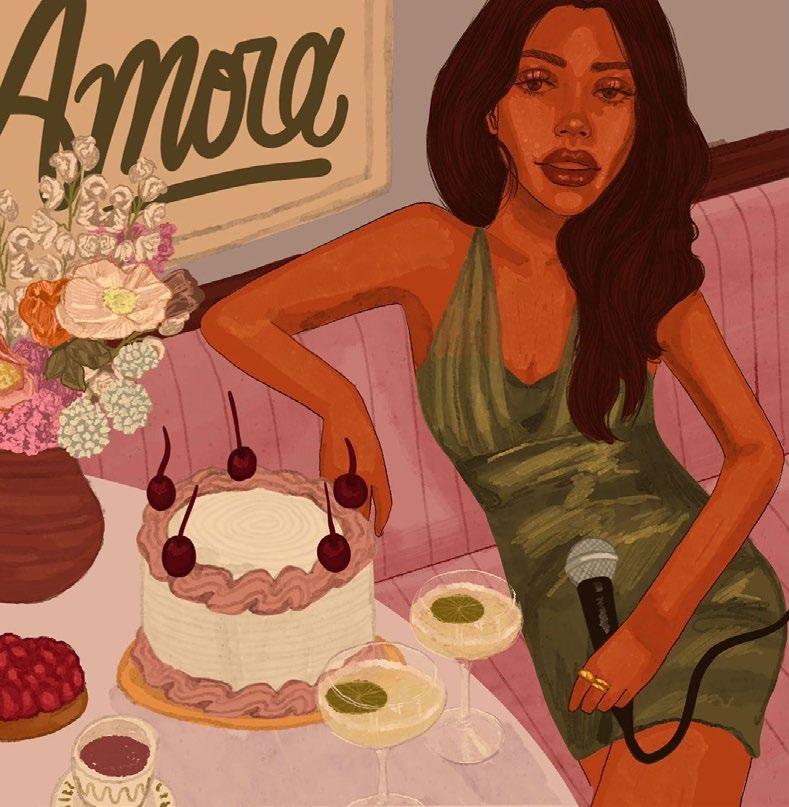 Words by Barbara De la Peña Cuevas (she/her)
Words by Barbara De la Peña Cuevas (she/her)
A plate of food carries the collective efforts of people, communities, and mother nature. It holds the evolutionary knowledge of generations past. Every single plate of kai is an opportunity to reconnect with our heritage, land, and pleasure.
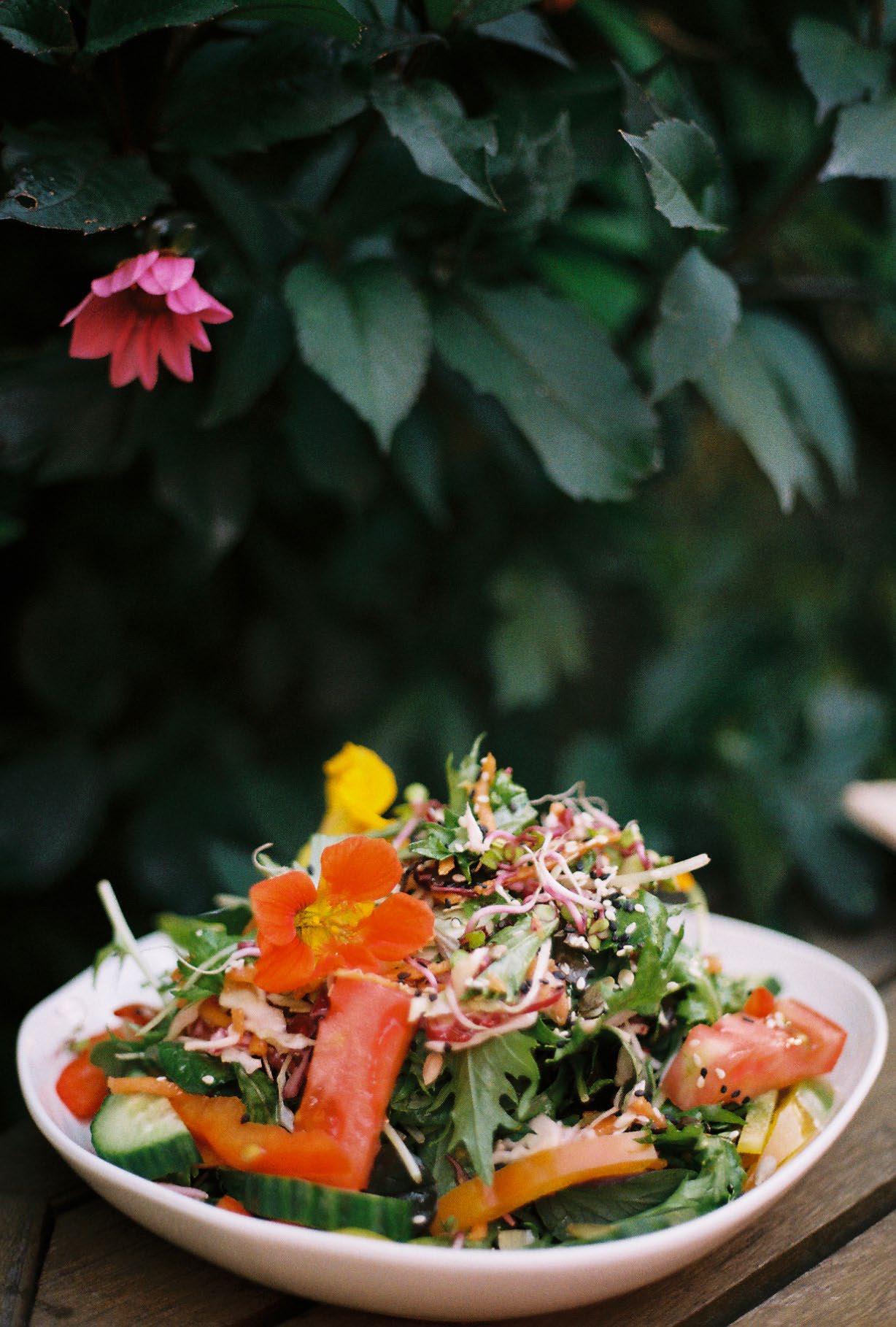

Acknowledging that cooking and savouring every bite is an experience not everyone has access to, reconnecting to food and celebrating it is an opportunity available to us. I have the honour to connect with listeners from all over the world every month and discuss our thoughts on pleasure, food, and inner and outer connection to the natural world through my podcast: Amora Podcast
During my travels overseas, navigating veganism, and living as a foreigner, I have found immense healing in cooking, eating, and sharing.
As a former anaemic and patient of body dysmorphic disorder (BDD), I have come to terms with the fact that the journey of healing and nutrition is non-linear. Some days it feels effortless, others feel like a never-ending battle. Here are some habits and ideas that have improved my nutrition, mental health, relationship with eating, and social life.
38 Columns
Disrupting mindless eating
Food has become a commodified artefact: industrialised, fast, and highly processed. We have become used to the fastness of deliveries and embracing distraction when eating. Sometimes, we might see eating as a chore or activity to do ‘in the background’, rather than a celebration of our bodies and senses.
Conscious eating, like other habits, requires practice and intentional input. Before eating, pause and feel your senses for a few seconds to break apart from the eating auto-pilot. Try closing your eyes, getting carried away by the smells. Try to untangle the components of your meal through your senses. What does your meal look like? Focus on the colours, the textures, and the arrangement. Which details may become pleasing to the senses? Take a couple of deep breaths in to bring your awareness to the present moment and indulge!
Practice gratitude
Gratitude is a practice that we can experience in many forms, smells, colours, and textures. It allows us to acknowledge what we do have and has proven to release stress and anxiety. It is simple; no matter if it is mentally or verbally, say “thank you”. Pausing to acknowledge the meal that we are about to take in makes it more enjoyable and may support mental and emotional health throughout the day, allowing other things in our field of awareness to enter through the scope of gratitude.
Food as a social prop
Eating from the same table and the same food puts people on the same emotional page. Food also functions as a prop that sparks social dynamics, conversations, and storytelling. Some of my most meaningful experiences with food have been preparing for a potluck where the main intent is sharing and bringing people together. Ultimately, our relationship with the ingredients that we utilise in the kitchen and our meals reflects our relationship with the natural world and how we inhabit it. We must ask ourselves: how do we behave in nature, in the land? What stories around the process of gathering, cooking, sharing, and eating have we chosen to believe? How can we step back to making eating and cooking simple, accessible, and as enjoyable as possible? How can we reconnect with ourselves, our bodies, and our current needs?
Connect to the wider contexts
“Where does my food come from?” is a question that we barely ask ourselves yet should try to respond to as often as possible.
Bringing into perspective all the forces at play that support us having a full pantry and access to fresh ingredients brings to light a bigger system that remains invisible under the norms of industrialised, automatic eating.
As you stand before the ingredients for your meal or a warm plate of food, imagine where everything comes from. Imagine what that place looks like and who might have harvested the vegetables, herbs, and spices that will feed you later. If meat is in your diet, imagine the animal in its perfect form, fulfilling its role in the natural world before making its way to you.
If you do not know where your food comes from or if it comes from places farther away, seek a closer link to those foods locally. Get to know your local farmers, your local and seasonal produce, your community gardens, cooks, and their stories. The non-physical world also plays a role in bringing food to life.
Ritualise cooking and eating
If cooking is in your possibilities, do it as often as possible. When we cook we are forced to remember that we are working with the natural world, with plants, and animals if we utilise them.
Cooking may also become a safe space to disconnect from the outer world and think about what you are doing at that particular moment. One of my favourite moments of the day is cooking to music I love, putting my phone on aeroplane mode for a few minutes, and fully immersing myself in the craft. I feel re-energised, more grounded, and refreshed after each meal I make.
Choose a time and space to contemplate, disconnect, and nourish yourself and others if you choose so. If it is only eating, utilise that moment as a time to bring your awareness into the present, focusing on your senses. If possible, do it as attentively as possible, as the main activity rather than something you do on the side. The process of eating and cooking is spiritual. When we eat, we take nature into our bodies. We are changed by what we eat, we fuel our physical and emotional bodies. Eating is our most profound engagement with the natural world.
39www.salient.org.nz






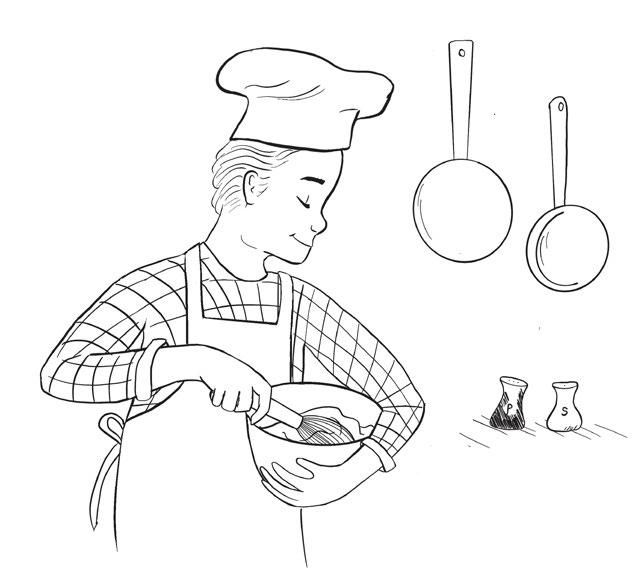



 Sudoku
Sudoku
Illustrations by Bells
Te Reo Māori: hua whenua vegetable New Zealand Sign Language: Instagram 40 Entertainment
1. Recyclable material; malleable (7)




5. Its national football team is nicknamed ‘The Atlas Lions’ (7)
9. 1929 Ernest Hemingway novel set during the First World War (1,8,2,4)
10. One who holds a deed (5)
11. Digs up, especially with heavy machinery (9)
13. Mercury who gave performances on the posthumous album ‘Made in Heaven’ (7)
15. Motors; search providers (7)
17. Like some dexterous circus feats (9)

18. Actor Channing of ‘The Lost City’ (5)
20. Things you can pick up in Wellington at Pegasus, Ferret, or Arty Bee’s (6-4,5)
22. Grew incisors and molars (7)
23. Add honey to, maybe (7)
1. Tiebreaker game; band (5)

Crossword: Themeless (Hemingway to Go) Across Down Word Wheel How many words can you make with these letters? All words must contain the letter in the centre circle. T I D L E M E I R Scan the QR code for puzzle answers: 41www.salient.org.nz
You’ve just realised something about yourself. Actually, I think it would be more accurate to say that there’s something about yourself you have always known, but can’t deny any longer...
Aries Cancer
This is your official reality check: people don’t constantly have you on their mind. For some Cancers, this means you need to tone down the ego. For others, it means stop feeling so self conscious, because who’s paying attention?
Taurus
It is so nice seeing you look after yourself properly and seeing you empowered by the connection between your mind and body. You’re literally “That Girl” (or Boy or Person).
So much has been happening in your fourth house (which is astrology speak for “your home life”). I know you’re exhausted, but everything that’s been happening has been purposeful and will eventually work out for the better.
Arguing with friends is so boring, Leo, especially when it’s about a difference in opinion. For example, arguing over whether or not “Malibu Barbie” is a good baby name is not worth the cost of a friendship.
It’s over. Hallelujah, it’s finally over. Mercury is no longer in retrograde and all Virgos can breathe. Finally, breathe. Make the most of this calm, because you’re a Virgo and you know full well it won’t last long.

Somebody is so in love with you, it’s amazing. I hope you know who or find out soon, since they’re head over heels. By the looks of it, you’re ready to be head over heels too.
Jealousy ain’t cute. Just cause you’re a Scorpio doesn’t mean you have a free pass. It’s your nature (or more accurately, your stereotype) to be possessive, but you need to stop for the sake of your relationships.
A pre-existing relationship is about to turn romantic...This could mean good or bad things. If it’s a friend: awww cute <3. If it’s a co-worker or flatmate: I dunno, this could be a lil messy.
You know that “big thing” you were so scared other people would find out about? Well, you had nothing to worry about. The revelation is a good thing, opening up lots of conversations and pathways for you.
There has been a change to your everyday life. Definitely not a dramatic change. Less spiritual, more practical. Think: new school bag, new alarm clock, new belt.
Your style of communication is clashing with someone you live with, or quite possibly, your partner. You need to be less vague and they need to be less specific.
Pisces
Gemini
Leo Virgo
42 Entertainment Capricorn
LibraScorpioSagittarius
Aquarius
















 Sub-Editor
Staff Writer Maia Ingoe
Staff Writer Zoe Mills
Azaria
Chief
Ethan Manera
Gosavi
Alice Brown
Sub-Editor
Staff Writer Maia Ingoe
Staff Writer Zoe Mills
Azaria
Chief
Ethan Manera
Gosavi
Alice Brown
Contributors Contact Us features@salient.org.nz poetry@salient.org.nz editor@salient.org.nz designer@salient.org.nz chiefreporter@salient.org.nz news@salient.org.nz Alice Crisp Cileme Venkateswar Maddy Troutman Barbara De la Peña Cuevas Lauren Pemberton Ash Putt-Fallows Charlotte Smith Niamh Vaughn Jenny Brown Bella Bolter Puck Sophia Willis
Tessa Keenan Features Editor Ronia Ibrahim Staff Writer Bridget Scott Social Media Manager Seren Ashmore Podcast Manager Francesca Pietkiewicz Website Manager Annalise Scott
The Salient Team News Editor Beth Mountford News Editor
Howell
Reporter
Editor Janhavi
Designer
You can thank these people for your weekly fix. 43www.salient.org.nz
NEED A
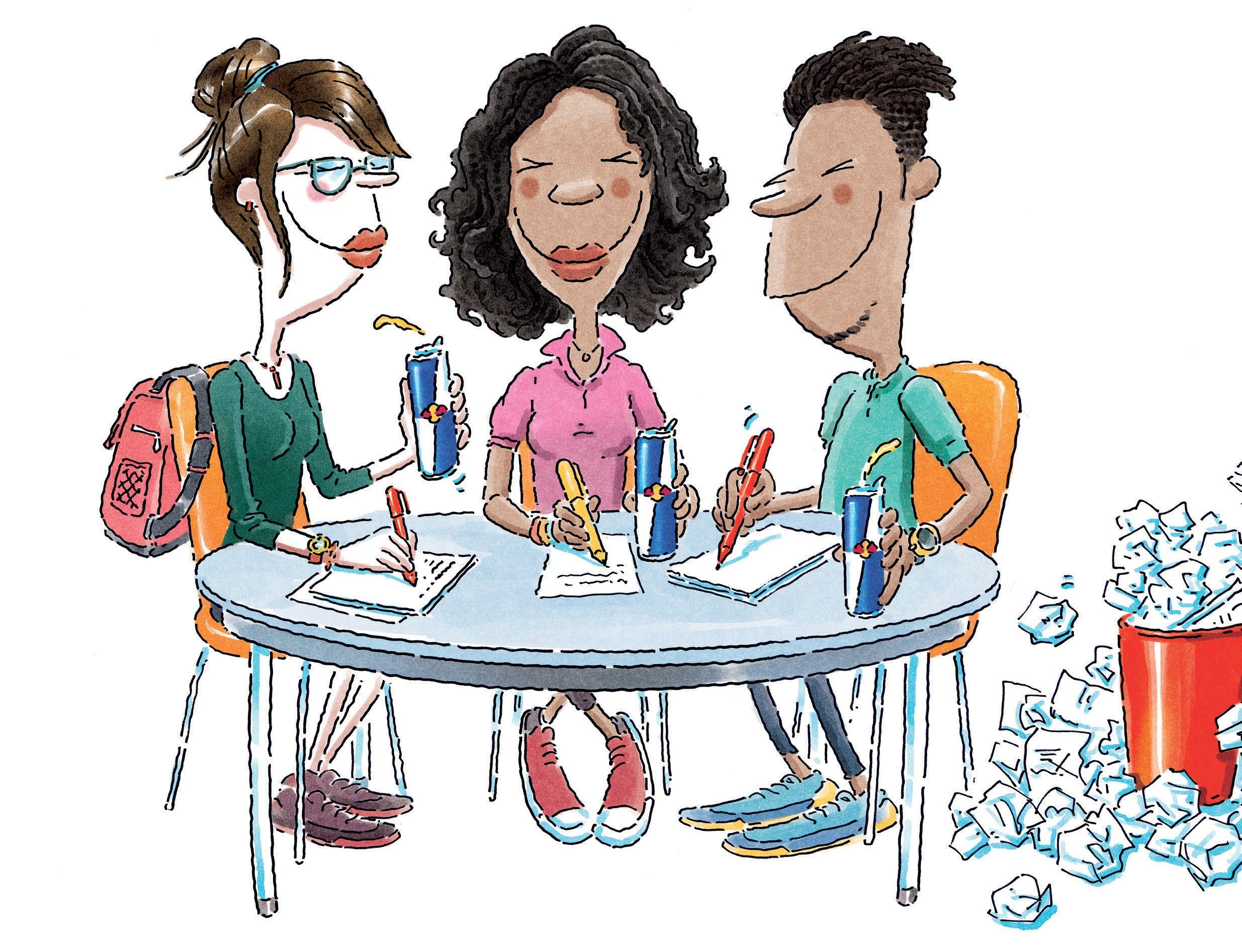
NEW STUDY BUDDY?
